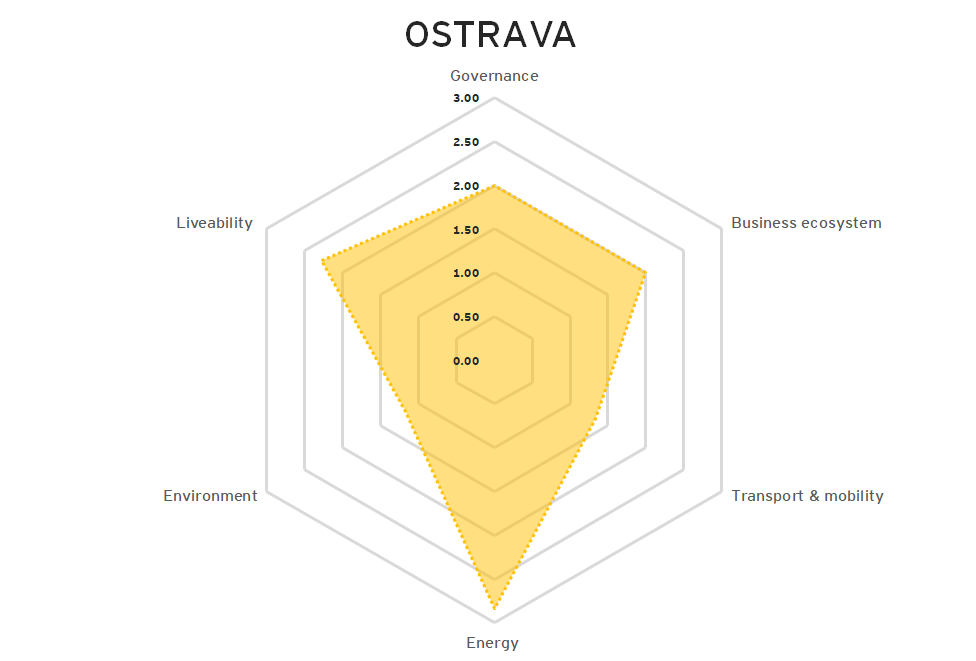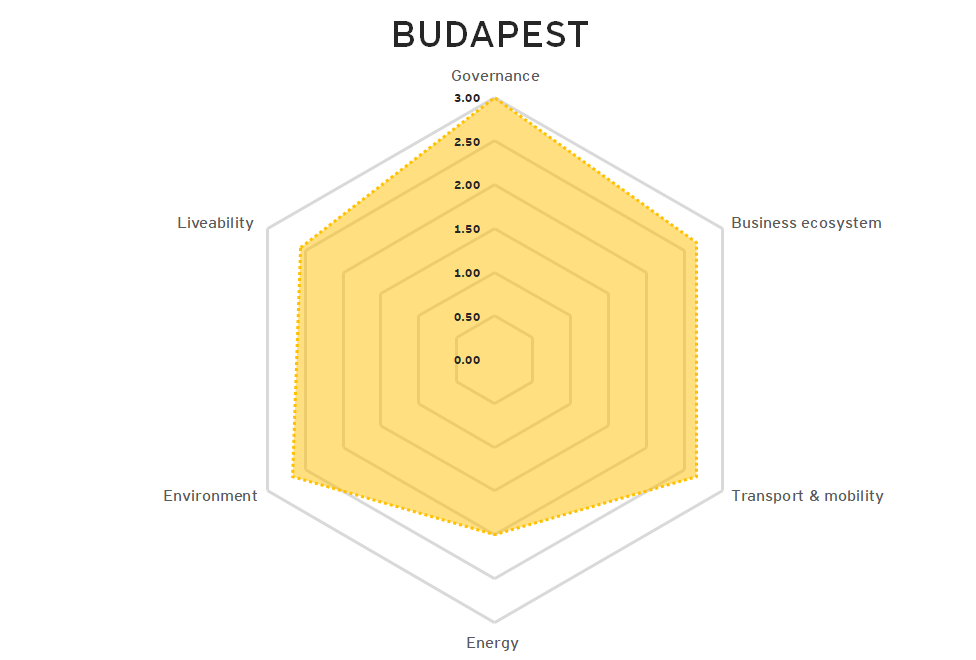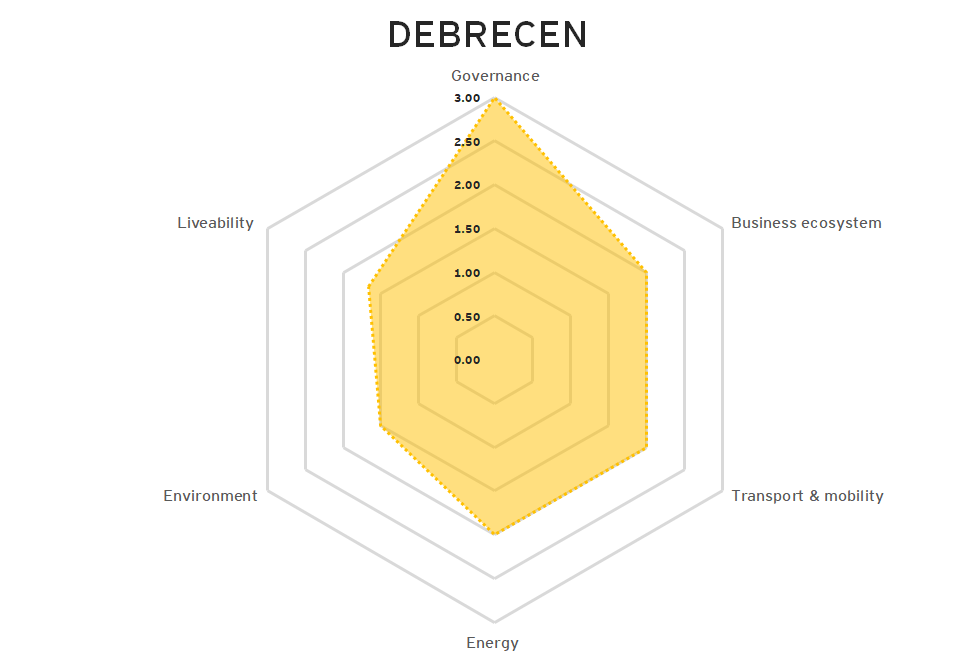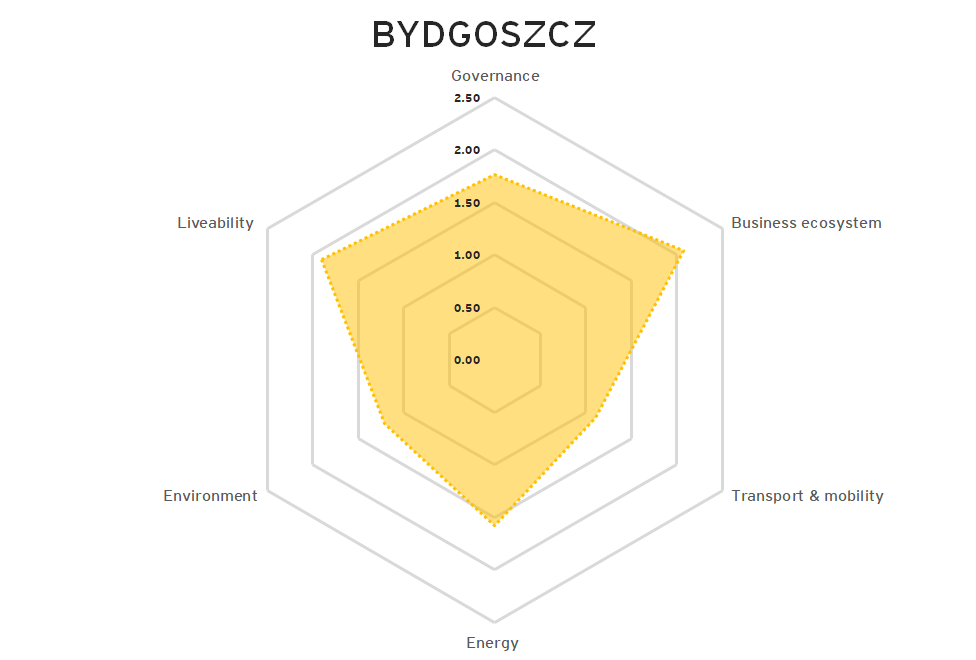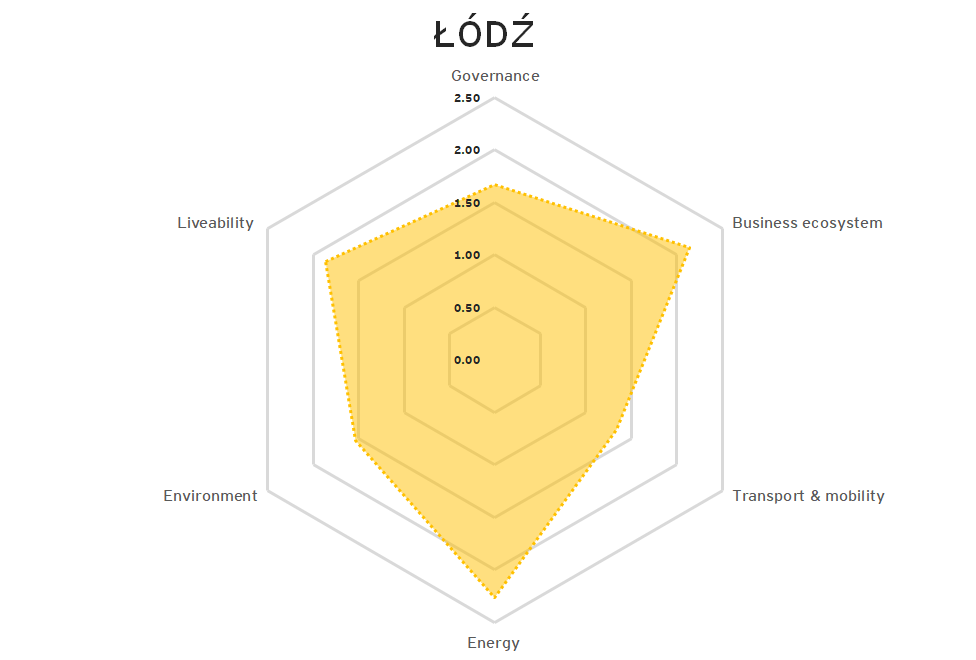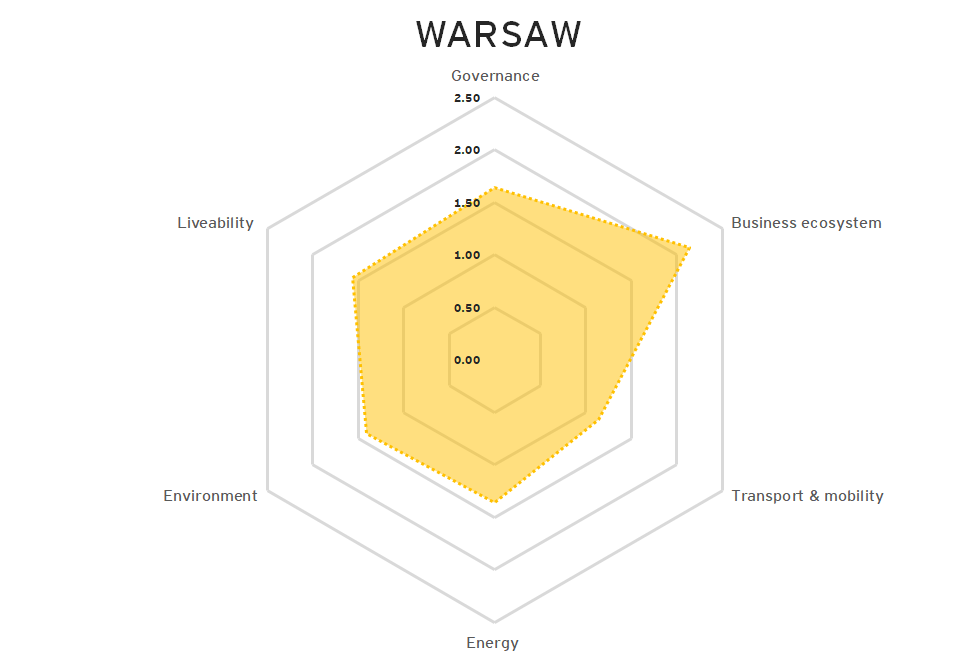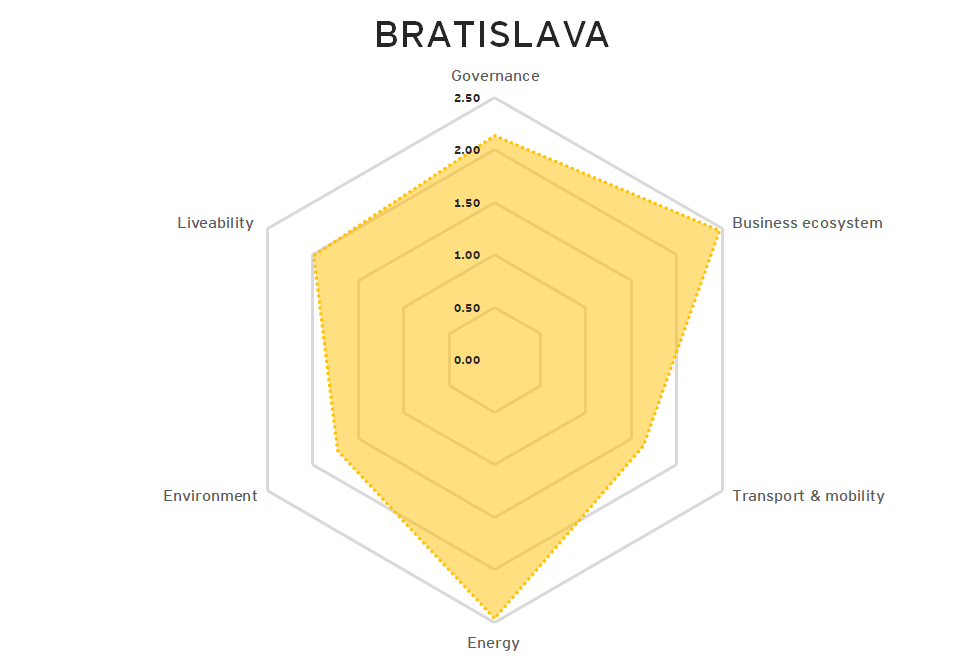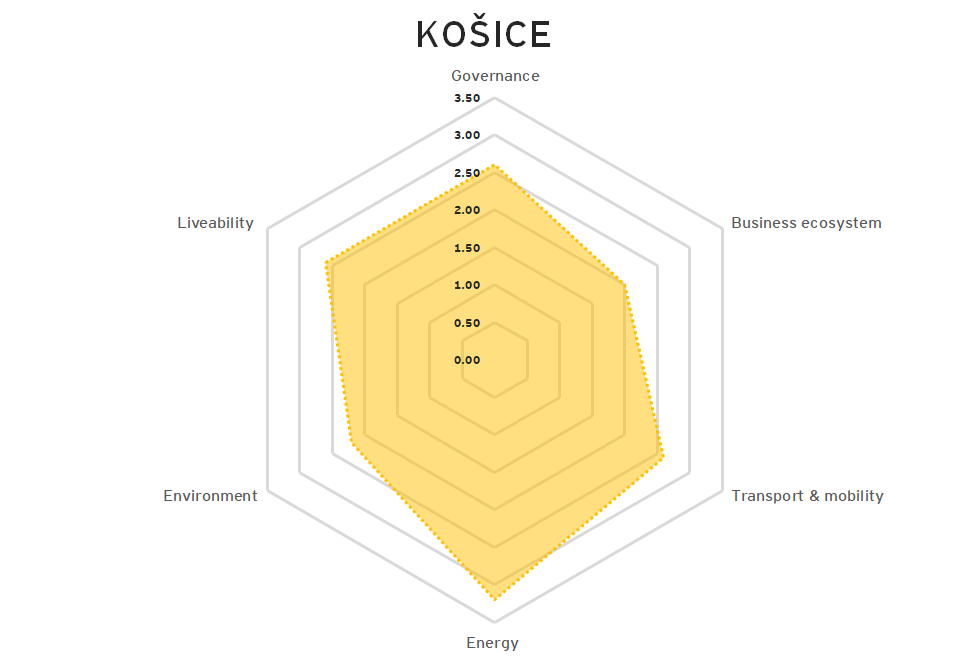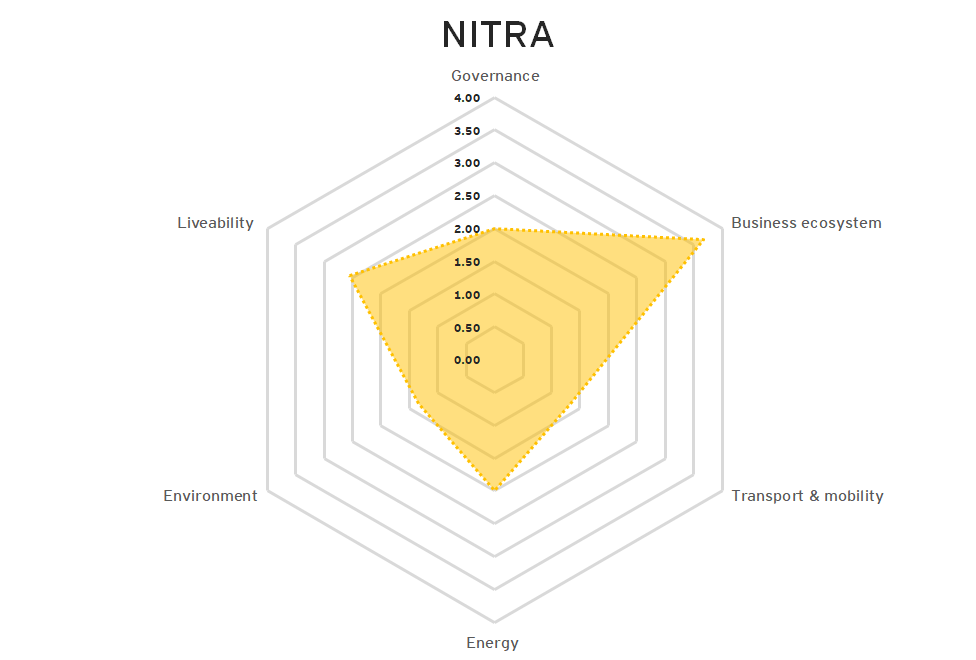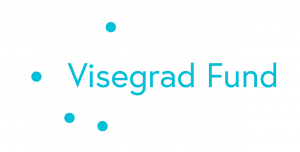
Evaluation of V4 cities in the area of Smart City
Final Report
This report was prepared by Consortium partners implementing the Evaluation of V4 cities in the area of Smart City project funded by the International Visegrad Fund (IVF).


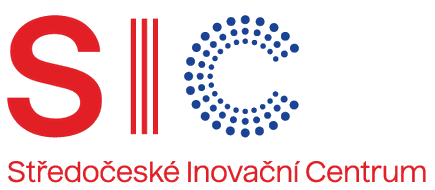
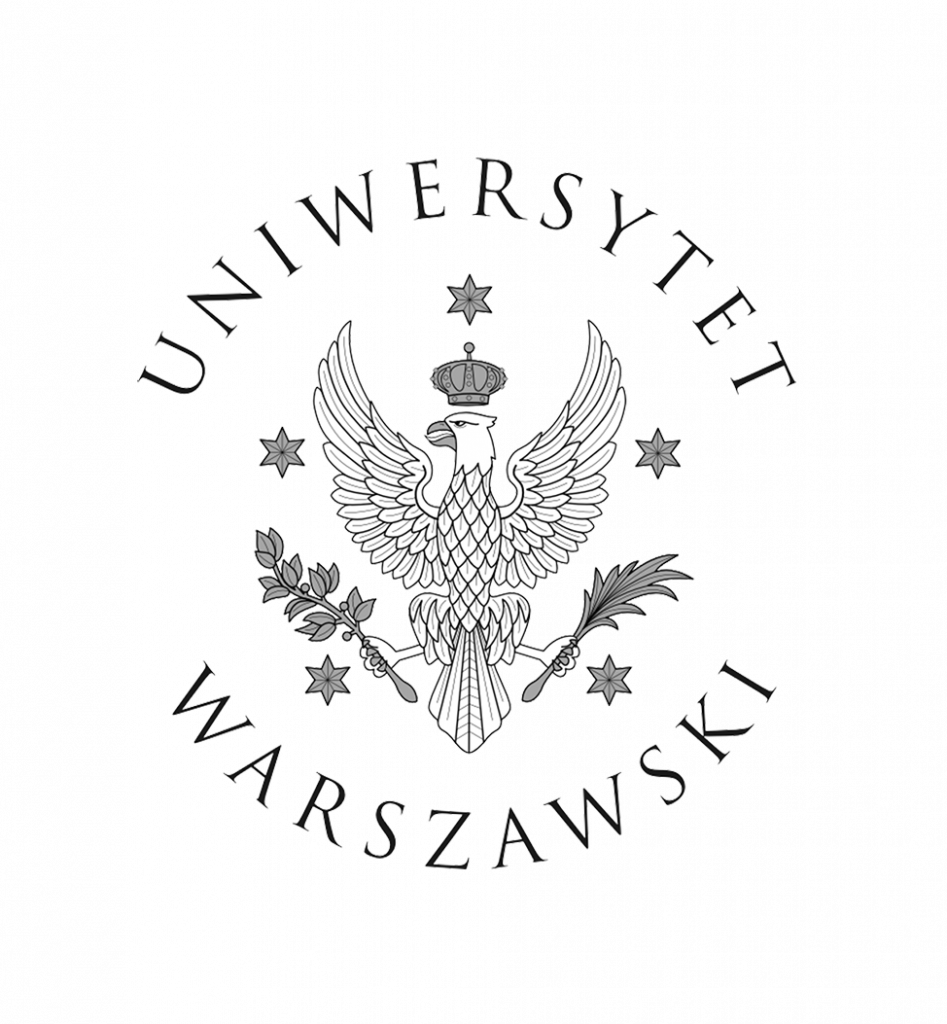
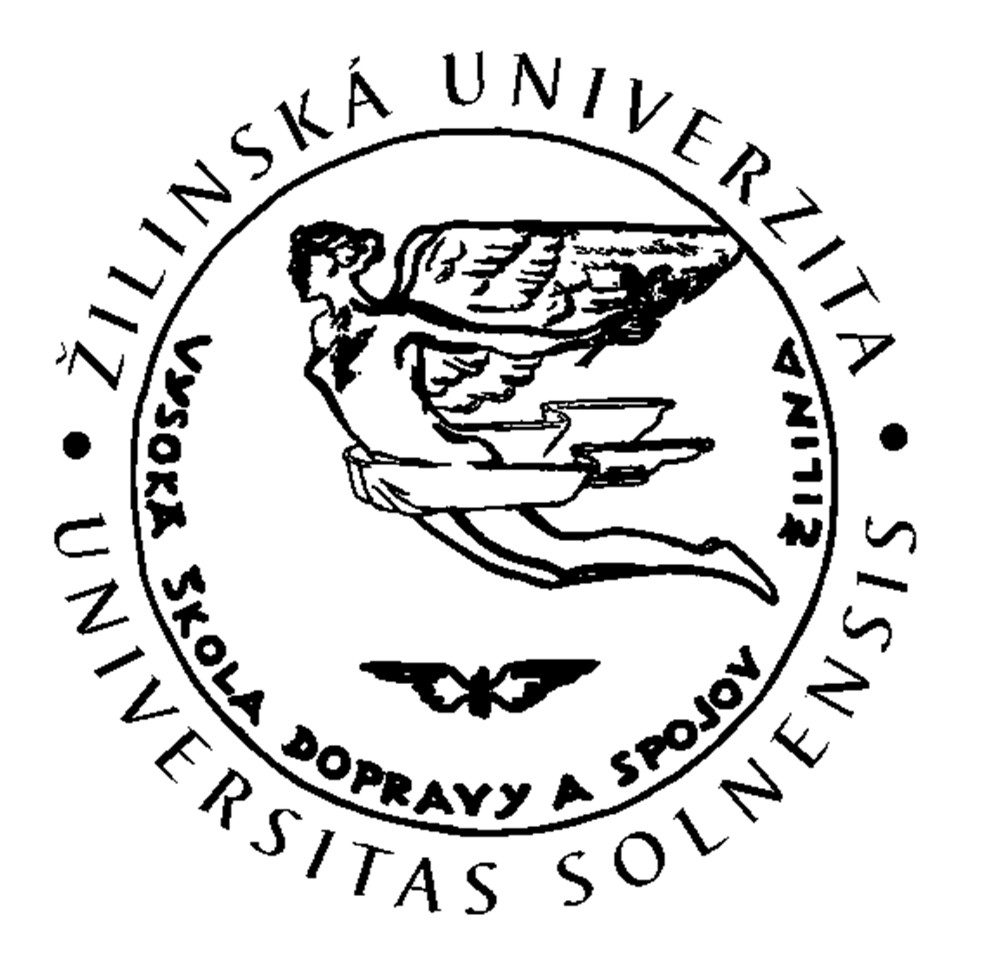
Executive Summary
Visegrad region level – summary
Sustainable urban development (often referred to as the SC concept) is a term commonly used to describe the evolution of modern cities. Given the increasing importance of this concept for the sustainability that improves the quality of life of its citizens, the research evaluates the current state of Smart City (further referred to as SC) concept in Visegrad region (in the Czech Republic, Slovakia, Poland and Hungary) from the perspective of all major stakeholders (municipalities, private sector representatives and citizens). The SC in this report is understood as a city employing optimal use of all interconnected information to better understand and control the operations of the city and optimize the use of limited resources through the implementation of new technologies, close collaboration with its citizens and businesses and by adopting an intelligent solution that enhances the services provided.
The report, building on the outputs of EY’s Self-Assessment tool (SAT), discovered that although the SC concept is perceived very positively and both citizens and private sector representatives are interested in having opportunities to contribute to it, just a few of the stakeholders consulted believe that the cities they live in fit to the SC definition.
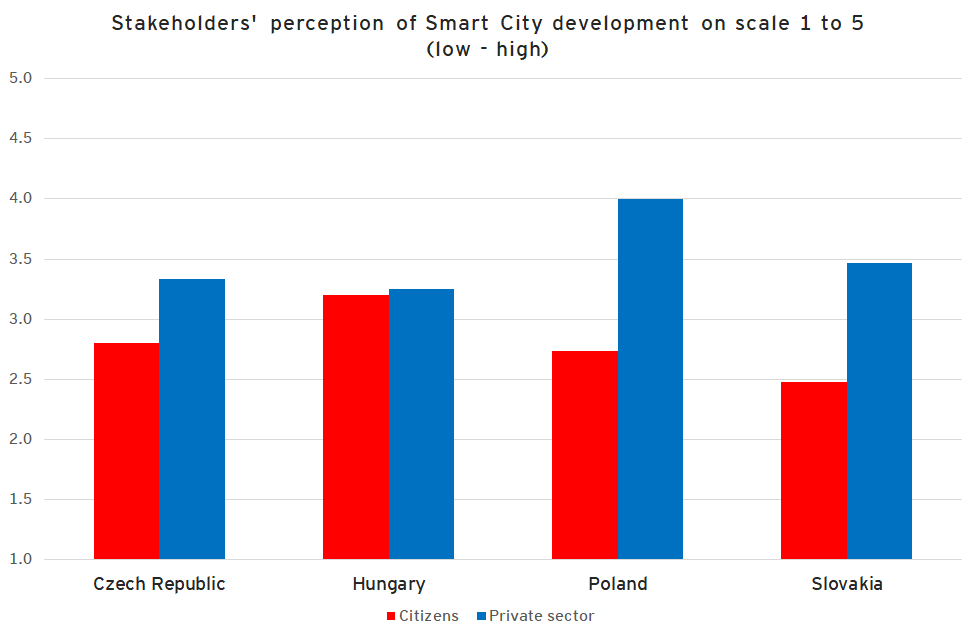
What is more, with one exception in the Polish city of Bydgoszcz, the lesser part of citizens was aware of their city’s vision and strategy in sustainable urban development and responses from the private sector were not very stimulating either. However, according to the research findings, cities in the Visegrad region had in some cases quite sophisticated SC strategies, as well as a high number of valuable and interesting SC projects in every city reviewed.
These findings indicate considerable potential for the improvement in communication between all levels of stakeholders. Practically speaking, the research showed that there was a lower engagement from the municipalities towards its citizens in the planning processes of their cities.
Moreover, the report’s respondents felt their cities did not utilize sufficiently various channels, both digital and non-digital to enable citizen engagement. In regards with the other major obstacles to SC projects, the regulatory framework, the lack of human resources at the city level, and the outdated urban infrastructure were reported as the most common denominators in all reviewed countries.
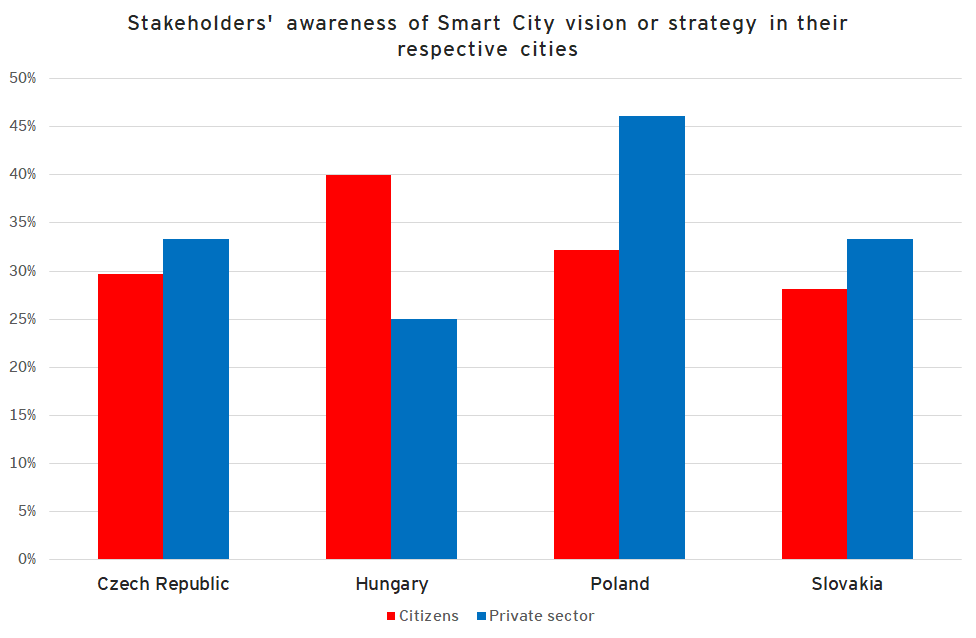
On the positive side, to support SC projects, there is a variety of financing options available in the region. The European Union grants are the prevailing source of financing for the SC projects, followed by the city budgets. It is recommended on V4 level to consider also other financing options, particularly those enabling self-sustaining SC solutions. According to the municipalities’ responses, the implementation of SC projects is mostly financed by Horizon 2020 programme, followed by LIFE programme, as well as the funding sources form European Structural and Investment Funds (ESIF) that are distributed at the national level through the local Managing Authorities. In terms of implementation of a SC project, simple contracting was the most common form of funding as opposed to more advanced ones, such as EPC or PPP.
Lastly, several municipalities stated that they utilize the form of repayable funding provided by the European Fund for Strategic Investments though in general the municipalities reflect the grants available at the market. Additionally, a few municipalities expressed an interest in the usage of funds from the Joint Assistance to Support Projects in European Regions (JASPERS) and INTERREG Europe 2014 – 2020.
Please click on the country image.
Czech Republic: Country Summary
Introduction: The Smart City (SC) concept is not an unknown term in the Czech Republic. Many organizations are dealing with this topic and there are nearly weekly seminars, workshops or conferences on this topic that anyone can attend. The Ministry for Regional Development in the Czech Republic is a methodological guarantor of the entire concept with its Smart City Concept Methodology, followed by the Smart City Funding Methodology, and has recently initiated s SC Working Group with the aim to coordinate SC activities in the country. Municipalities are aware of the SC concept and implement SC projects but with different results among them. Last but not least, there is a considerable number of actors who are attempting to positively influence the implementation of the SC concept into practice, namely numerous private companies such as members of Czech Smart City Cluster (E-ON, T-Mobile, EY, Schneider Electric, and many others) that is the pioneer of SC in the Czech Republic. Universities are very active in SC, for example, Czech Technological University (CTU) dedicated special facilities for the SC named University Center of Energy Efficient Buildings in Buštěhrad (UCEEB) and the recently opened Center of City of Future located at CTU-CIIRC (Czech Institute of Informatics, Robotics and Cybernetics).
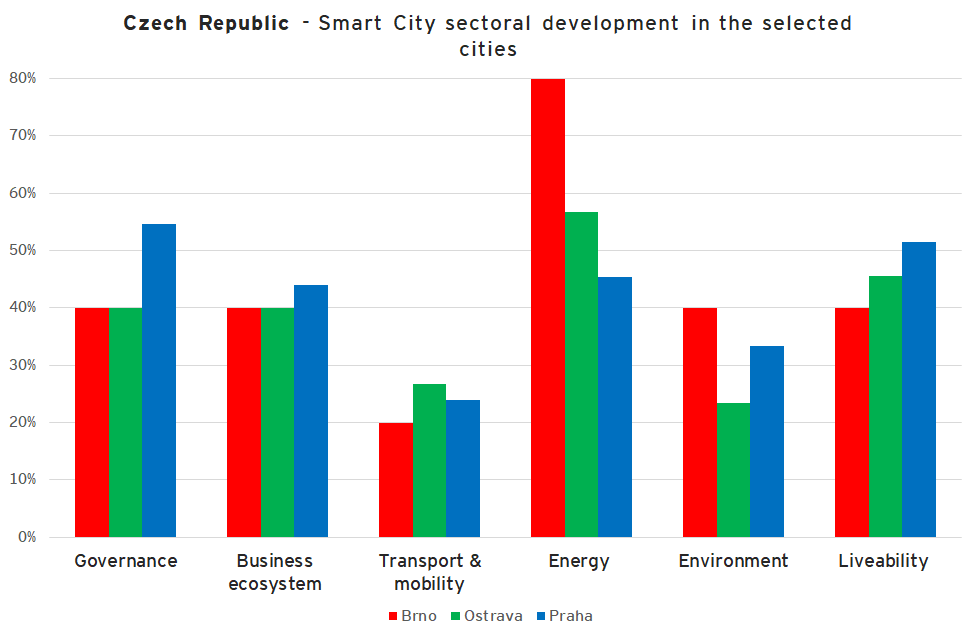
EY Self-Assessment tool findings: The survey showed that the majority of respondents from both private sector and the citizens in the Czech Republic see SC concept and sustainable development as a value-added activity in improving the quality of their lives and business environment. However, despite seeing the importance of SC concept, most respondents from both private sectors and citizens were not aware of the cities’ vision and strategy in the area of sustainable urban development – Smart Cities and even fewer respondents knew who to address regarding this agenda. Interestingly enough, while all stakeholders from the private sector were interested in the possibility of more active participation in the development of their cities, only slightly above 40% of citizens expressed this interest.
The research showed that in most Czech cities, there was a similar list of obstacles to the successful development and implementation of smart projects. First and foremost, regulatory framework seems to be the biggest obstacle in implementing the SC agenda in the Czech Republic. Furthermore, lack of human resources at the municipality level, outdated urban infrastructure, lack of proven or accessible technology and lack of investment and finance seem to hinder SC development and implementation in the Czech Republic.
In regard to the SC financing, Czech municipalities are predominantly in favour of financing from the municipal budget or European Union grants. Drawing money from the national budget and regional and national grants is less common but still a present option. Only one municipality reported having experience with private investment for financing SC development and implementation. In fact, grants were identified as an appreciable source of financing for SC agenda in the Czech Republic. Participating municipalities stated that they have financed the implementation of SC projects mostly from Horizon 2020 programme, followed by LIFE programme as well as the funding sources form European Structural and Investment Funds (ESIF) that are distributed at the national level through managing authorities. Also, using the form of repayable funding provided by the European Fund for Strategic Investments was twice stated as a used option.
In terms of recommendations, communication is an area requiring particular attention. First and foremost, the real meaning and benefits of the Smart Cities concept must be communicated towards citizens but especially towards the municipalities. One of the feasible ways is facilitating events such as hackathons, open challenges, and open data initiatives or creating an innovative program such as SC labs, accelerators. In fact, Czech citizens were among the least aware of these initiatives in all V4 countries. Mobile apps and web-based portals are also a good way of communicating with and raising awareness among citizens and other stakeholders.
It is further recommendable to develop a common framework for evaluating Smart Cities solutions to recognize the true benefits of individual projects and to be able to evaluate them. Creating a common framework for evaluation of Smart Cities solutions would also ease up developing the professional capabilities of municipalities in order to reliably assess technical parameters of the projects.
Touching upon regulatory framework being identified as the biggest obstacle in implementing the Smart Cities agenda in the report, improving current SC strategies by closer cooperation with legislators rather than creating completely new strategies might be a valid solution.
Last but not least, given the fact that only one municipality in the report had an experience with SC financing different than city and national budgets and grants, it is recommendable that municipalities focus their attention towards self-sustainable and market-based SC financing options rather than relying solely on grants. As such, if there was still a need to obtain further financing for SC projects, consortium members recommend exploring also direct and intermediate loans, venture capital, equity investments, guarantees, green bonds, technical assistance as viable options.
Final recommendations: Overall, more can be done to promote and implement SC in the Czech Republic. The consortium members have observed that during the years the term of SC might have transformed into an unclear image of what SC concept actually is. Part of this issue is the overuse of the SC concept for commercial use by companies obscuring the true benefits of it. This results in a certain restraint of municipalities to focus on SC development. What’s more, while municipalities are constantly bombarded with SC solutions, they don’t have a system in place to evaluate the technical level of such solutions nor exist a certification system for such solutions. As such, they do not have sufficient professional capacities to evaluate the SC projects’ technical parameters when trying to implement the SC solutions. Once implemented, municipalities also struggle with maximizing utilization of data collected from SC projects and rely on using the data in the future.
Czech city level: Prague
Introduction
The Czech Republic is a relatively centralized country with Prague being the main economic and cultural center of the country. The survey confirmed that Prague offered a well-developed business ecosystem for private sector stakeholders but citizens were comparably less satisfied with living in Prague. Interestingly, the private sector perceived Prague to fit the SC concept better than according to the perception of its citizens. In fact, citizens think Prague fits in the concept of SC only from 2,86 points out of 5 possible (with 5 being the highest).
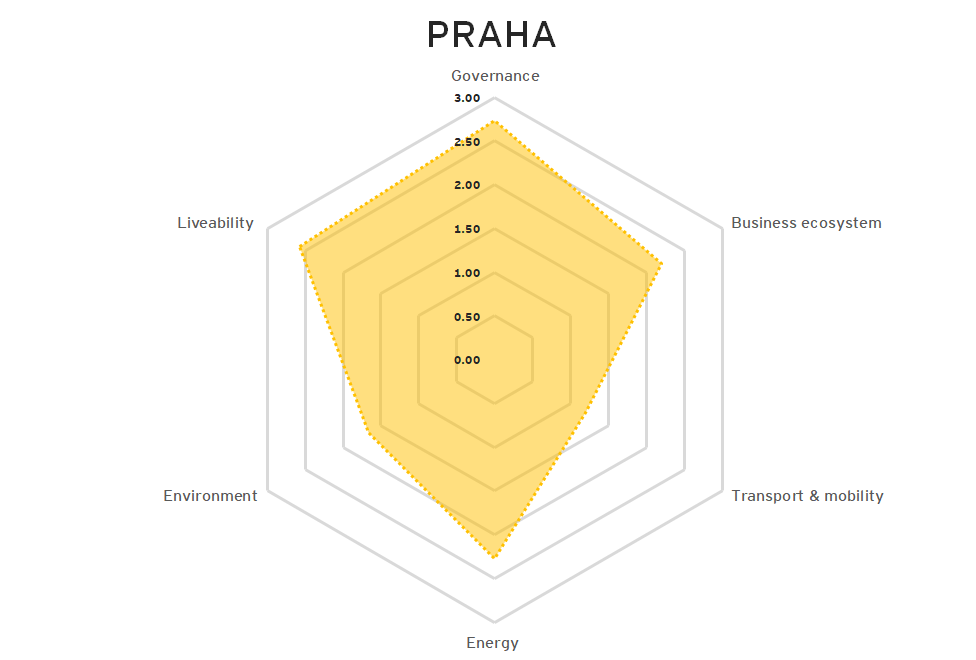
Strategy
The city of Prague developed Smart Prague – Vision 2030 concept as a comprehensive strategy for SC development. As a tool for promoting the concept, Prague created the platform www.smartprague.cz. Furthermore, the Institute for Planning and Development has developed the Strategic Framework Smart cities for Prague by 2030. In theory, this framework is supposed to be the umbrella document for the concept of SC in Prague. Furthermore, some administrative units in Prague have their own strategies, for example, the city district of Prague 3 developed a strategy „Prague 3 on the way to Smart Cities”.
The main coordinator of activities is the city-owned company called Operator ICT that collaborates with the Institute for Planning and Development and works with the Institute’s SC framework.
Key Smart City actors and projects
The Smart Prague concept is based on the use of the latest technologies for transforming the capital into a better living space. As such, it requires the involvement of many key players including Prague City Hall, Operator ICT, Prague Institute of Planning and Development, Charles University, Czech Technical University, Prague Public Transport Company and Technical Management of the Roads in the Capital of Prague. Municipalities administrating Prague’s city districts have been active in Smart Cities, too. Last but not least, many companies have been active in SC, many of them are the members of the Czech Smart City Cluster.
There are numerous projects led by the municipal leaders as well as local administrative units having SC projects under their leadership. On the municipal level, SC strategy for Prague is divided into 6 basic areas: Mobility of the future, Big Data, Attractive tourism, Smart buildings and energy, People and the urban environment, Wasteless city and involves tens of projects. Some of the realized or ongoing project are Golemio – Data platform, Testing interactive mobiles (Testování interaktivního mobiliáře), Compression baskets (Kompresní koše), Water management SWiM (Vodohospodářský SWiM), Non-contact payment (Bezkontaktní platba jízdného) or Metropolitan emergency and health care system as a joint SC project with other partners.
On the district parts, some of the progressing projects are Revitalization of the park in Prague 2 district, Revitalization of the bike path in Prague 3 district or a project for camera system digitalization in Prague 5 district.
SC opportunities and recommendations
The results from the survey indicated two focus areas for improvements: Transport & Mobility and Environment. In the case of Transport & Mobility, it might be viable to enhance the deployment of the initiatives such as Smart parking, Intelligent Traffic Management System and Sustainable Public Transportation. On the other hand, the city scored well for its proactive approach to Car-sharing systems and Transportation information accessibility.
The second space for improvement identified in the report was the Environment, where Prague came with just 1,67 out of 5 points. In fact, responded perceived Prague was active in terms of Waste collection optimization but increased attention could be directed towards under-developed areas: Urban farming and green roofs, smart water metering, waste-to-energy projects, use of recycled water and rainwater utilization.
Last but not least, it is recommendable to familiarize its citizens with available mobile apps that improve their quality of life. In fact, only 50 % of its citizens were aware of any application which belongs to the lowest awareness level in the report.
Czech city level: Brno*
Introduction
The city of Brno announced an open call for cooperation in the development of the SC concept in Brno in 2015, marking the start of SC in this city. The aim of this call was to create a network of active organizations and people (urban ecosystems) to take part in the development of the city.
The survey displayed that citizens felt better to live in Brno than company representatives felt Brno featured a good business environment. Citizens had also a better perception of Brno fitting into the definition of SC than the private sector (3 and 2 points respectively out of 5).
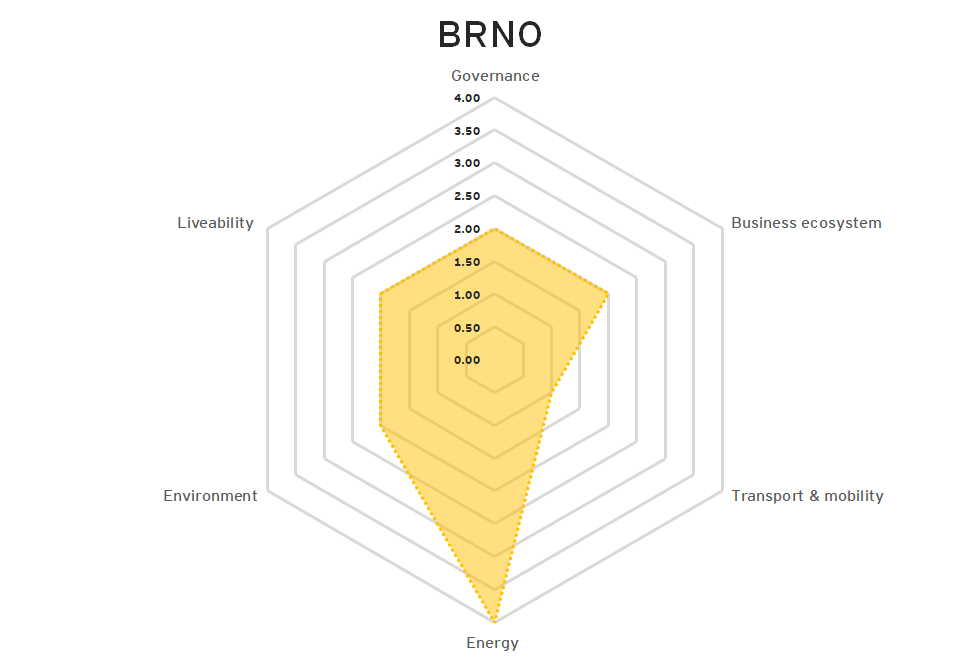
Strategy
The priority for Brno is the creation of the strategic document Smart City Brno 2050 that is currently under construction. The document will describe the entire city issues with the intention to achieve high quality of life and sustainable development. This conceptual document will contain the concrete goals including the measurable values, terms, and responsibilities. Main areas of SC Brno are: Smart resources, Smart living – Quality of life and Smart governance – City administration.
The unit responsible for developing the SC concept is the Commission of Brno within the Brno city municipality.
Key Smart City actors and projects
There are various stakeholders involved in SC in Brno. Namely, Brno Science Partners (Universities, research and development centers and the Czech Academy of Sciences), Brno Business Alliance composed of private sector representatives, Non-Governmental Organizations, Brno Smart City Community, Brno Managing Members.
Brno is active in both European and largescale projects as well as local ones. RUGGEDISED is a cooperation with other European cities while sharing the experience SC in the implementation of the smart solution in social, economic and environmental topics with a common goal of increasing the quality of life of their citizens. Brno ID is a platform that helps access public and communal services (public transportation, waste, zoo and other services) through one place online. Brno is active in involving students in SC, for example through the project MUNISS. Interestingly, Brno is involved in the project Hyperloop that strives to enable futuristic transportation.
SC opportunities and recommendations
The results from the survey indicated three focus areas for improvements, Transport & Mobility, Environment, and Liveability. There was still a potential for improvement in areas of Governance and Business ecosystem, too.
When it comes to Transport & Mobility which seems to be an area requiring the most attention, the survey showed Brno was less active in fields of Car-sharing systems, Smart parking and E-Mobility. In the area of Governance, there was a space for improvement identified in Open Data initiatives and Digital public services. In terms of Business Ecosystem, Brno could focus more on Open Data Ecosystem for business purposes, financial programmes to support local businesses and support of established local suppliers and businesses. In the area of Environment, Brno was less active in the case of Smart water metering, use of recycled water, urban farming and green roofs. Brno’s Liveability was lacking on Integrated and digitized health and social services, sharing economies, smart tourism concept, smart schools, and the skills for future workforce, sports and leisure facilities in the report.
*Just 1 response from the private sector representative was considered in
the validation of the Brno survey’s data.
Czech city level: Ostrava
Introduction
Ostrava, the third biggest Czech city, has a slightly different approach towards SC than the other two Czech cities in this report. In fact, Ostrava’s citizens are above average (3,33 points out of 5 with 5 being the highest) satisfied with living in their city, however, they perceive Ostrava to be fitting in the context of smart cities less (2,83 points out of 5). Unfortunately, private sector representatives did not share their views on the above-mentioned areas.
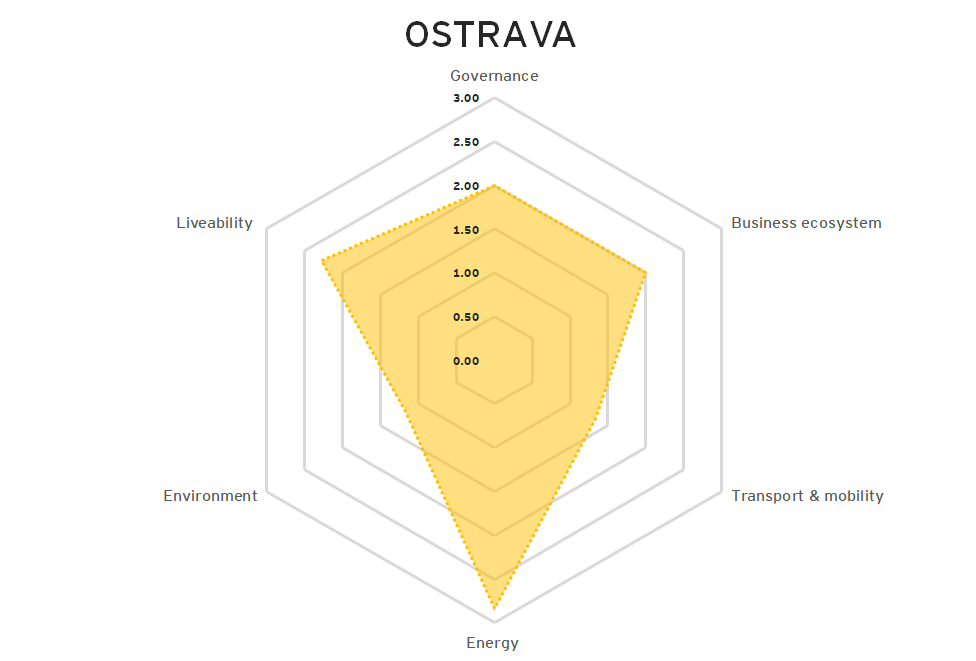
Strategy
The concept of the SC in Ostrava is created by the Department of Strategic Development. It mainly focuses on encouraging the citizens to be more active in public life. Furthermore, the Ostrava City Strategic Development Plan 2017-2023 contains objectives in the area of SC. The main project of the Strategic plan is creating an excellent research center (National Competence Center) to develop new technologies and solutions to improve quality of life with an emphasis on efficient use of energy resources and intelligent traffic management. Finally, one of the key concepts of the Ostrava Smart City is fajnOVA which is a platform that gathers new ideas directly from citizens as well as informs them about the strategic development plan and strategic projects. Department of Strategic Development of the city of Ostrava develops the SC concept.
Key Smart City actors and projects
Except for the Department of Strategic Development of the city of Ostrava and National Competence Center responsible for rather a strategic part of SC, there are numerous stakeholders involved in SC projects. Namely, City of Ostrava, VŠB – Technical University of Ostrava, University of Ostrava, Tieto Czech s.r.o., ArcelorMittal Ostrava a.s., Vítkovice a.s. and other private sector representatives.
Under the concept Ostrava fajnOVA, there have been tens of project implemented or are being in progress of developing. Generally, the city of Ostrava’s main objective is introducing eGovernment and Smart Cities for more efficient public administration. Another critical goal, particularly important in Ostrava’s region, is improving the environment and air pollution thanks to SC devices. The implemented and ongoing projects can be clustered into several categories, namely building an interconnected city, revitalizing the historic city centre, being a centre for top-quality education, enhancing the business environment, supporting communities and citizens’ involvement in public life, creating a great environment for all generations, bringing the city closer to the nature and other projects.
SC opportunities and recommendations
The results from the report indicated three focus areas for improvements, Transport & mobility, Environment, and Business Ecosystem. Particularly, in Transport & mobility area there were perceived many spaces for improvements and as such it is recommendable to attempt to deploy innovative concepts such as Smart parking, Car-sharing systems, and E-mobility.
Whereas Ostrava focus lies in Governance (e.g. introducing SC for more efficient public administration) and in Environment (reducing the pollution), it might still consider raising the awareness of its SC communication tools, because the awareness of its citizens, for example about the Web-based portal belonged to the lowest in the report. In addition, in terms of Ostrava’s environment, more could be done in using recycled and rainwater, smart water metering, urban farming and green roofs, and waste-to-energy projects.
Hungary: Country Summary
Introduction: The concept of Smart City (SC) spread in Hungary mainly thanks to the non-repayable grants and the efforts of the private sector which creates a specific situation in the development of SC in Hungary. Municipalities remain reliant on non-repayable grants from the EU as well as from the state budget. There are several government initiatives to accelerate SC development, and 56/2017. (III. 20.) Government Decree by defining ‘smart city’, ‘smart city methodology’ determined a unified nationwide set of concepts.
Smart City is a horizontal theme in the frame of the Digital Welfare Program, in which the research, strategy making and action plan intend to address the current deficiencies. Practically speaking, the grants that meant the SC widespread also restricted the scope and vision of the projects, resulting in isolated projects functioning without an overarching strategic framework to give clear direction to the development. A market-based approach is almost entirely absent from the thinking of municipalities in these cases. Following the negative experiences of private sector stakeholders with public sector actors have encouraged them to move towards other private sector actors. Yet, they remain open to their involvement in the SC.
On the other hand, in county-cities and other larger cities in the country, the basic conditions of Intelligent City development are available, greater or lesser successful pilot projects are in place, and opportunities for systematic development are improving. Furthermore, their bonding is also visible to EU (and within that EU Danube Region) cities, to the west and the east alike. Several Hungarian cities have built professional connections enabling the sharing of experiences from foreign cities ahead of them. Some universities are active in SC, such as the University of Debrecen for example in co-developing Hungary’s first Smart Campus, fully compliant with 5G requirement.
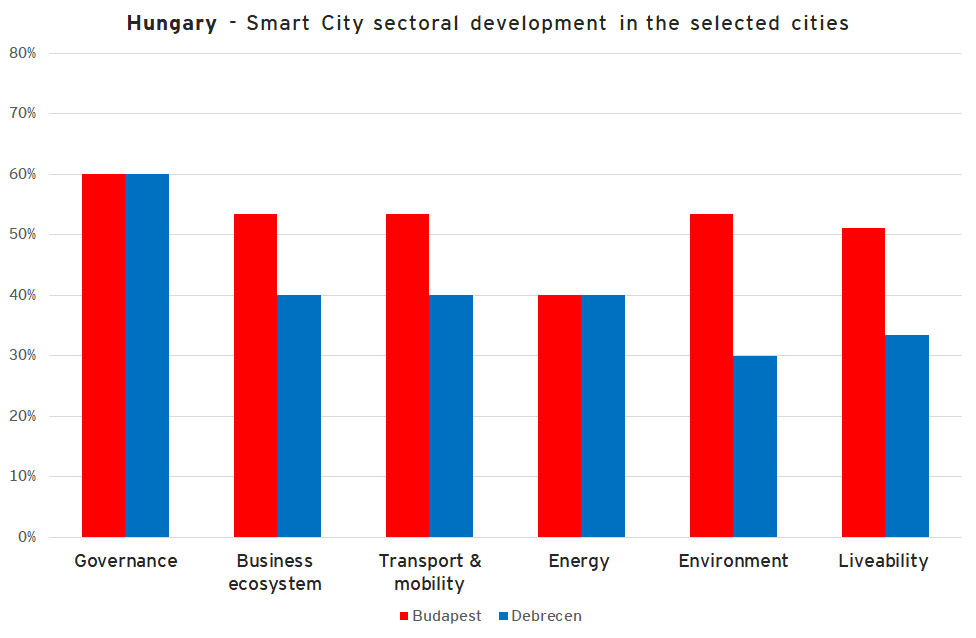
EY Self-Assessment tool findings: The survey showed that while respondents’ satisfaction was relatively high for Hungarian citizens participating in the survey, the satisfaction of private sector representatives with the business environment was comparatively lowest in the four researched countries. Interestingly enough, a similar trend was visible in terms of awareness of the Smart City’s vision and strategy in the Hungarian cities – Hungarian citizens were more aware of the SC activities than the private sector representatives (40% compared to 25%). In fact, the same number of citizens (40%) were aware who to address in regards to the Smart City and urban development agenda in their cities, compared to even less (13% from the private sector). However, despite relatively low awareness in the private sector, most of these stakeholders seem to be interested in the possibilities of more active participation in the development of their cities but still with the lowest interest from all participating countries. On the other hand, the citizens showed the highest interest in these opportunities as well as the perception of the Smart City concept and sustainable urban development as a value-added activity among all V4 countries.
The research showed that there are numerous obstacles to Smart City projects. The regulatory framework is perceived as the biggest obstacle to the Smart City projects, followed by lack of human resources at the municipal level, outdated urban infrastructure and lack of proven or accessible technology. The respondents placed high also the obstacles associated with the lack of investment and finance, security and/or privacy issues, infrastructure ownership structures and lack of consumer demand.
In regards to the SC financing, the responses showed that Hungarian municipalities are not very used to financing the SC projects. However, most of the financing comes from the European Union grants, followed by regional budget, green bonds and technical assistance. European Energy Efficiency Funds, Innovative actions in sustainable development, INTERREG Europe 2014 – 2020, Danube strategy and also the repayable funds provided by European Bank for Reconstruction and Development (EBRD) were claimed as the most frequently used funding sources by Hungarian municipalities.
To move the SC concept forward from both development and implementation perspectives, the consortium members recommend opening a dialogue between the municipalities and the private sector with the inclusion of the final beneficiaries, the citizens because they showed to be particularly interested in Smart Cities. Clearly articulating the common goals of all these stakeholders and opening the dialogue with the legislators would be one of the viable options in improving the regulatory framework to support SC.
The research showed some best practices in developing and deploying innovative Smart Cities while including universities in facilities such as science parks. The consortium members recommend continuing in these efforts and extending the cooperation to the municipalities. Such activities could be beneficial in the long run, for example by incentivizing the students to take on the work in municipalities addressing the important issue of lacking the needed human capital in the municipalities.
Last but not least, drawing from the experience of the survey participants from SC financing in Hungary, it is recommendable to explore more financing options and not relying only on European funds or regional budget. In fact, the consortium members perceive it as important to find self-sustaining and market-based smart city projects that will not rely solely on grants. If the project would still require further financing, direct and intermediate loans, venture capital, equity investments, guarantees or private investments could become viable alternatives.
Final recommendations: The particularly present issue is that cities lack adequate capabilities and capacity to collect and analyze vast amounts of data, especially visible in cities other than Budapest. There is a need for a basic infrastructure that allows for the data collection. To react to this, the government decided it was necessary to secure 30 Mbps bandwidth Internet access the whole country area. Hungary’s private sector has invested significantly in developing solutions tailored to the needs of the Hungarian public sector, however, these efforts did not lead to realized business opportunities. Yet, companies are still willing to engage the public sector when it comes to providing smart solutions and services, however, now with a more sceptic attitude.
Hungary city level: Budapest
Introduction
The city of Budapest is an economic and cultural center of Hungary. However, despite a big part of the economy is centralized in this capital, private sector evaluates business ecosystem at 4 points of out 5 (5 being the highest). Budapest’s key parameters identified in the report in terms of enthusiasm about SC concept among both citizens and the private sector. All respondents from both groups reported SC concept to be a value-added activity in improving the quality of their lives and all of them were interested in possibilities of more active participation in the development of Budapest. However, despite their enthusiasm about the SC concept, Budapest’s citizens evaluate their satisfaction with the city of Budapest relatively low and slightly worse than the private sector. Budapest seems to be also under average on fitting the definition of the Smart City (2,67 points for citizens and 3,33 point out of 5 for the private sector) and in comparison, to other V4 cities in the report, too. On the other hand, at least one citizen knew a person whom to address with regards to the SC agenda compared to none from the private sector representatives in the report.
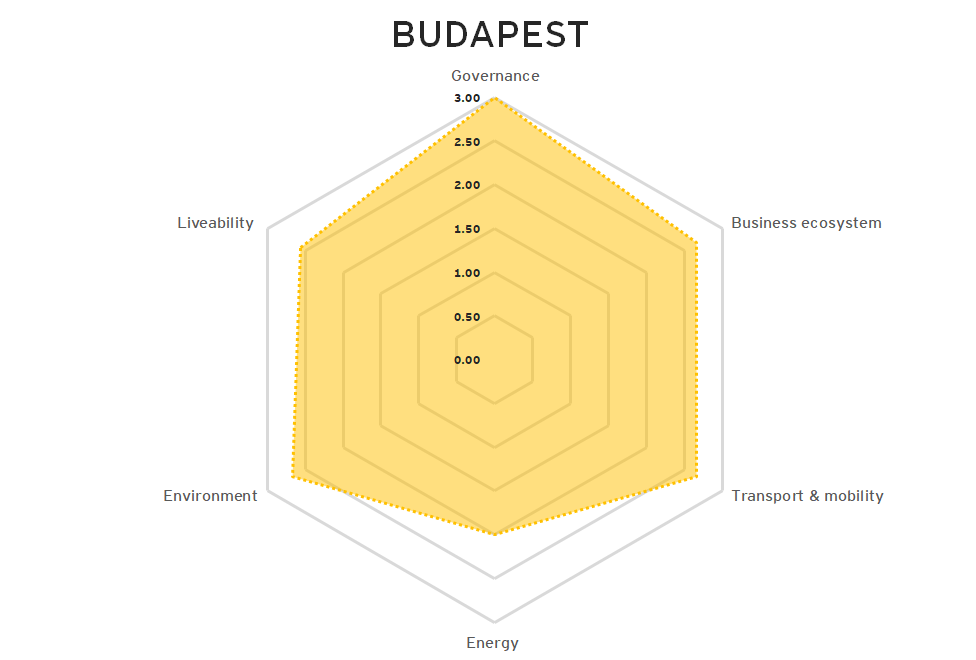
Strategy
The city of Budapest prepared a SC vision called „Smart Budapest – The smart city vision of Budapest”, which functions as a framework for SC objectives. It articulates three pillars around sustainability, modern technology and social responsibility. It summarizes key component and strategy belonging to the SC agenda such as Budapest lighting masterplan, Budapest integrated energy strategy and action plan or Budapest water management concept. Municipality of Budapest that is responsible for the SC vision of Budapest.
Key Smart City actors and projects
Except for the municipality of Budapest above, the Smart City Budapest (SCB) Initiative is very active in SC. It unites projects and organizations in Budapest that are connected to the Smart City concept, such as Mindspace Nonprofit that is one of the main stakeholders of SCB. Mindspace’s main purpose is to activate in-field initiatives in Budapest and link them with the international ones. Other actors are Budapest Centre of Excellence for Smart Cities – an incubator of smart cities concepts and solutions, and the Budapest University of Technology and Economics (BME) that has a unique knowledge of smart cities, particularly in the Danube region. There are also numerous private companies driving SC in or from Budapest, namely T-Systems Ltd, IBM Hungary Ltd., Antenna Hungaria Ltd. or ABUD Engineering Office Ltd.
Budapest has been relatively active with the European SC projects. There are programs for making Budapest energy effective as well as building intelligent energy infrastructure. For example, Sustainable Outdoor Lighting and Sensory Urban Network (SOLSUN) aims at creating a smart city infrastructure that is cost efficient and sustainable and another project, coordinated energy-related PPIs actions for cities (CEPPI) is a representative of a smart procurement. Mobility has been an important SC area and Budapest follows the trends such as bike-sharing. As such, MOL Bubi – bike-sharing is a good SC example of public-private SC partnership.
Furthermore, there are numerous community-based SC projects. One of the prime examples is Better Budapest project under Shared Cities: Creative Momentum initiative with its sharing economy platform improving the quality of life of its citizens. Use/IT Budapest Map or Market and neighbourhood revitalization program with V4 partners is another set of examples of both community and European cooperation.
SC opportunities and recommendations
Overall, Budapest was evaluated well in most of the SC areas with the lowest score in the energy area. If there is a perceived space for improvement in Budapest in the energy field, we would recommend focusing on improvements of these areas: Energy Open Data, smart grids and energy storage, renewable energy, citizen involvement in energy efficiency, energy performance rating of public buildings and smart metering.
Furthermore, data showed that while both citizens and private sector were highly interested in opportunities in actively participating in the development of Budapest, only a few of them thought Budapest fitted to the SC definition nor were aware of who to contact in this regard. This indicates a great opportunity for improvement of communication between municipalities and its citizen and private sector. It is recommendable for Budapest to involve citizens in the decision-making process and improving tools for communication with them.
Last but not least, there is a perceived space for improvement in the quality of life of Budapest citizens through enhancing access to healthcare and supporting the ageing population, for example by leveraging benefits of eHealth concept.
Hungary city level: Debrecen
Introduction
Debrecen, the second biggest city in Hungary, is active in SC agenda and its citizen perceive its development positively. The respondents approached within the report felt relatively well satisfied with the living in the city, confirm continuous improvements in the quality of life for its citizens and out of all V4 cities in the report think their city fit into the SC definition most. However, only half of them are aware of Debrecen’s SC strategy and the same amount know a person whom to address with regards to the SC agenda. Only half of the respondents were also interested in opportunities of more active participation in the development of Debrecen.
Municipality of Debrecen: Debrecen adopted rather a bottom-up approach towards to SC development. The SC concept has been driven by the initiative „Debrecen Smart City” which is reporting directly to the Debrecen municipality.
It leverages the cooperation between the city, private businesses, NGOs, the University of Debrecen. These stakeholders are currently involved in creating the official SC strategy drafting valid for the years to come.
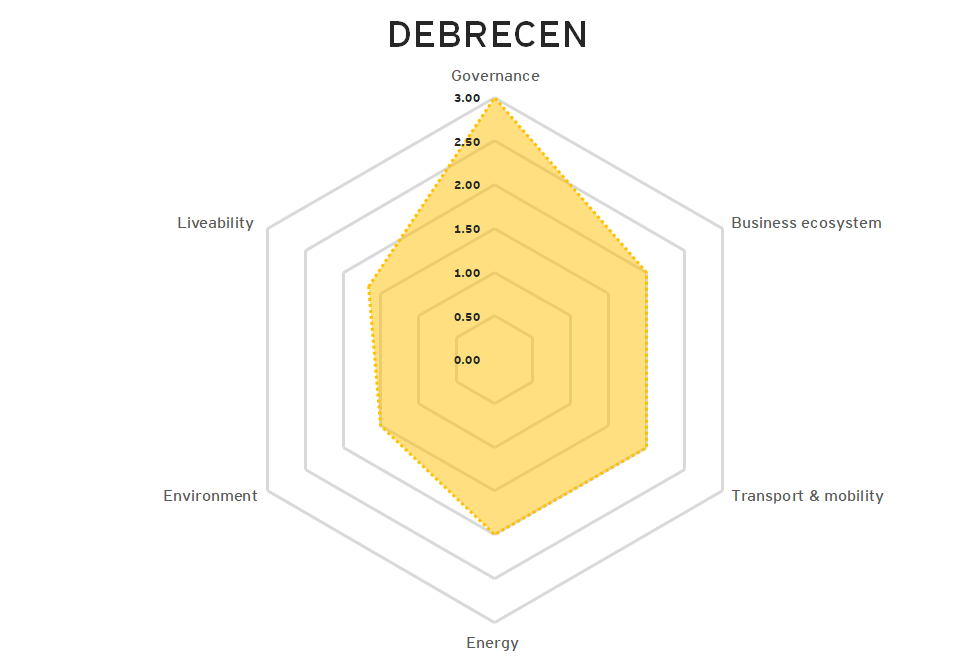
Strategy
Given its bottom-up approach of the city of Debrecen, the city of Debrecen started deploying the SC projects first and then conceptualized its approach based on in-field experience. The SC strategy is currently under development and reflects the gained experience from more than 13 projects. However, although, it is not an official strategy, the city of Debrecen leads its SC activities through its framework called Debrecen Smart City. It comprises three pillars: „Digital Literacy”, „Energetics” and „Transportation”.
There are two main stakeholders that jointly coordinate SC concept in Debrecen. The municipality of Debrecen directly and EDC Debrecen Urban and Economic Development Center whose Smart City is one of the key areas to.
Key Smart City actors and projects
Except for the above-mentioned municipality of Debrecen and EDC, particularly active is the University of Debrecen that is developing the first 5G compliant smart campus. Waze from Google enables to provide smart transportation to the city. There are also other private sector providers active in SC, as per example BMW is building a state-of-art factory that with new requirements for digitalization and sustainability and cooperating on local infrastructure improvements.
There are currently 13 projects implemented or running with a goal to improve the Debrecen’s quality of life and the well-being of its citizens. Two of them are in the area of transportation can be considered to be most significant: DKV E-Ticket in public transportation and WAZE community-based map application for Debrecen’s traffic. Others project in transportation are Rollet parking, Free Wifi on Trams, Debrecen’s first Smart Zebra Crossing, Ticket vending machines.
The city of Debrecen is active also in SC energy area and as such, Energy Mushroom and Smart energetics projects are being currently implemented. Last but not least, digital literacy projects are interwoven among the above-mentioned ones as well as several project focus purely on supporting digital literacy, namely NI Mentor Program, Smart Citizen, QR codes tourist information system, City Wi-fi and DIM Online Interface.
SC opportunities and recommendations
Drawing from the report responses, the following areas for improvements were identified. First and foremost, the environment. In fact, environment is the area that is currently not aimed at as a priority in Debrecen Smart City conception, however, it will become increasingly important with the regional growth Debrecen is currently experiencing.
Next area of recommendation is the liveability to its citizens and particularly their engagement in decision-making related to Debrecen’s urban development, access to eHealth and sharing economies. More can be done also in terms of the business environment, for examples supporting open data ecosystem for business purposes or creating support programmes for marginalized groups of Debrecen’s citizens.
Poland: Country Summary
Introduction: The overall development of Smart Cities (SCs) in the country can be characterized by a fragmented approach towards the implementation mechanism. Despite the diversity of urban needs, the SC agenda is decentralized, having no official representatives allocated to address its progress on the national and municipal level.
The SC concept is reflected in various solutions and mentioned in strategic documents, while there is no cohesive SC strategy, as well as investment plans. However, several national documents depicting development directions and indicating potential investment areas can be distinguished. The main document concerning the SC agenda is the Strategy for Responsible Development until 2020, with the perspective for 2030, focusing on the improvement in diagnosing socio-economic problems, promotion of social participation tools, air quality improvement and sustainable mobility (development of e-mobility, and after 2020 also the replacement of the public transport with eco-friendly and low-emissions fleets). Apart from that, since SC cover numerous areas of urban development, there is a number of other documents dealing with the SC agenda, for example, National Municipal Policy, Program of Integrated State ICT Development, E-mobility Development Program “Energy for the Future”, National Waste Management Plan, or National Broadband Plan.
The main public bodies dealing with the SC agenda in Poland are the Ministry of Investment and Economic Development, Polish Agency for Enterprise Development, and the National Center for Research and Development. Poland has a well-developed SC ecosystem with many corporate and private entities, institutions and universities, who are highly interested and involved in the SC agenda. The most common areas of SC projects in Poland as per today are energy efficiency and smart mobility.
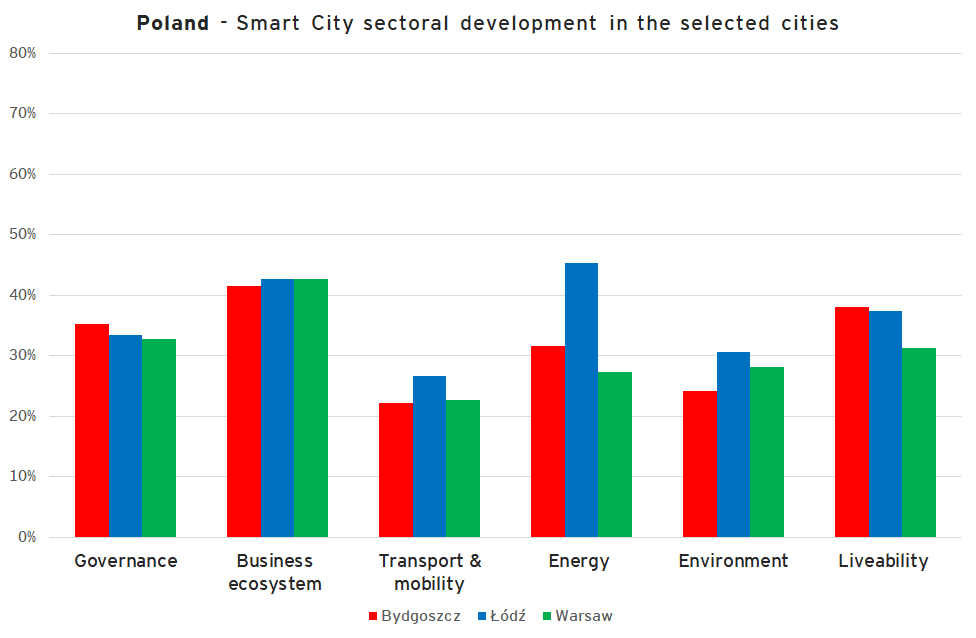
EY Self-Assessment tool findings: The report conducted during the compilation of this report showed that most Polish municipalities’ citizens are satisfied with living in their cities. The analysis showed a high level of SC concept and sustainable urban development awareness. Commonly for many Polish cities, both citizens and the representatives of the private sector are very interested in contributing to the SC development, thus improving the quality of life in the towns they live.
The research showed that there is a list of obstacles to the successful development and implementation of smart projects similar for most Polish cities. Thus, the most common obstacles are the lack of investment and human resources at the municipal level, the issue of the infrastructure ownership structures, security and privacy problem, as well as the current regulatory framework.
In terms of SC projects financing, Polish municipalities prefer quite a conservative approach towards choosing funding instruments, limiting the available options to taxes, regional budget, and green funds; while simple contracting remains the main form of cooperation with municipalities for projects in all smart areas.
Final recommendations: To facilitate the SC development and overcome the current challenges local municipalities face today in Poland, the local governments may firstly consider investing in the innovative and advanced funding structures. For example, the municipalities could consider the expansion of the funding instruments available for the SC projects, leveraging city and national budget; promoting the use of direct and intermediate loans, equity investments, venture capital, and grants; or providing the projects with technical assistance. Moreover, additional forms of cooperation such as public-private partnerships, concessions, or energy performance contracting could be implemented.
Secondly, enhancement of communication and citizens engagement is also very important in Poland’s case, as, for example, most of the respondents highlighted the need for having more SC participation opportunities, which confirms the ineffectiveness of the existing interaction and feedback channels. The reader may get acquainted with more detailed recommendations in respect of the communication channels’ suggestions on the city level of the report.
In addition, as described at the beginning of the section, the municipalities might consider investing into people on the local authority level as raising the awareness of the smart concept, existing problematics and effective solutions is crucial for decision-makers who deal with the issue.
Lastly, an analysis of the existing regulatory framework could be conducted, questioning its effectiveness and identifying bottlenecks in terms of modern urban development trends and SC solutions with a possibility of further adjustments applied on the national level.
Poland city level: Warsaw
Introduction
Poland is a centralized country, Warsaw as the capital city is the center of education, business, and creative industries; it is the seat of government administration and various national institutions. Resulting from the already developed infrastructure, know-how, and the extended ecosystem, the case of Warsaw is outstanding in terms of the SC potential.
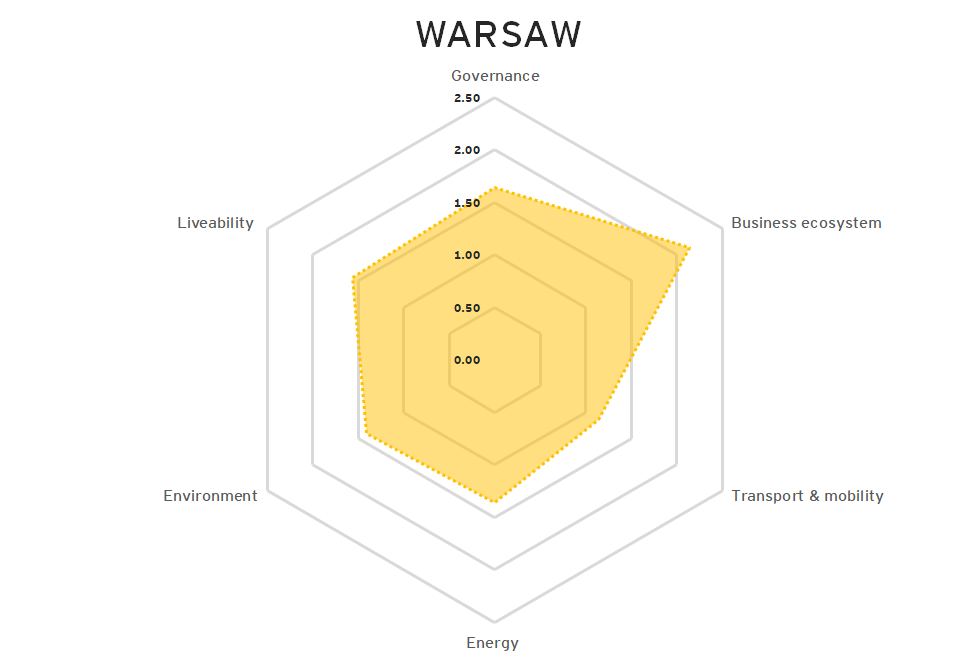
Strategy
The following documents can be distinguished among the key SC initiatives and action plans: #Warszawa2030 Strategy, Regional Operational Program of the Mazowieckie Voivodship 2014-2020, Investment program: Long-term Financial Forecast for 2018-2045, Development Strategy for Mazowieckie Voivodship 2030, and Innovative Mazowsze.
Although, similarly to other Polish cities, Warsaw doesn’t have a coherent SC strategy, the SC Projects Division (as part of the City Digitization Office) was designed as a special public unit dealing with SC issues within the Warsaw municipality.
Key Smart City actors and projects
Warsaw has a rich ecosystem of stakeholders participating in the SC agenda consisting of municipality institutions such as the center of entrepreneurship Smolna and center of creativity Targowa; companies such as mPay, Philips Lighting, Orange, Cisco, BuroHappold Engineering or SCs; local startups Scroot, Activy, Ifinity and Migam; accelerators and funds such as Startup Hub Warsaw or Huge Thing, the Heart Warsaw; academia institutions: Warsaw School of Economics, University of Warsaw, and Warsaw University of Technology; NGOS and other institutions: Centrum Cyfrowe Projekt: Polska, TechSoup Polska, Kultura Liberalna or Res Publica.
Warsaw‘s administration is gradually introducing new SC solutions. The municipality is conducting a number of activities in the area of transport and mobility, quality and competitivity of life, as well as social participation, such as: Warsaw 19115 city contact center, participatory budgeting program, open data portal, city bikes system Veturilo, highly advanced public city transport with electric buses, Park+Ride system, map of urban traffic disruptions and congestion, charging station for electric cars, hot spots, intelligent heating network, and Warsaw air quality index.
SC opportunities and recommendations
Analyzing the three Polish cities considered in this report, Warsaw’s citizens and the representatives of private sector ranked the city as the lowest in terms of an overall satisfaction, though it still was slightly above the report’s average level. The study showed that Warsaw has the highest rating of the existing obstacles to SC projects, it is interesting to note that unlike the other Polish cities the leading obstacle in Warsaw is the current regulatory framework, which is quite common for other Visegrad region cities and might be set as the main target for the local municipalities to focus on.
In terms of SC communication and citizens’ engagement Warsaw might be characterized as a city with the overall above-average results, having a significant potential for further development. Thus, for example, Warsaw takes the lead over Łódź and Bydgoszcz in terms of organizing hackathons, various open challenges, and face-to-face events. The city is also successful in maintaining SC mobile applications and facilitating business accelerators. At the same time, the consortium members would recommend the local authorities to focus on the enhancement and promotion of the open data initiatives and co-designing workshops, and especially on the organization of SC labs as this area was ranked lowest in Warsaw.
Poland city level: Łódź
Introduction
Łódź is profiled as the center of business services, the city continuously builds the brand of an investor-friendly city – in 2016 and 2017 the metropolis received a distinction of the most investor-friendly city at the Eurobuild Awards Gala. Despite that, in the upcoming years, Łódź is planning to overcome a few currently present challenges in the area of revitalization of urban spaces, unfavourable demographic trends, and the competitiveness of larger urban centers, with the help of SC projects.
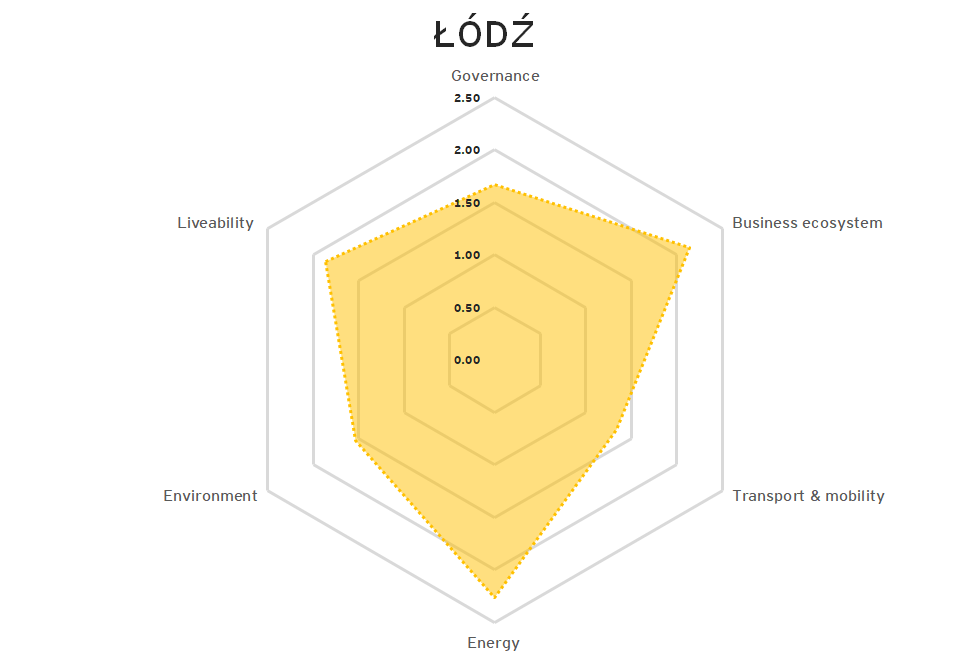
Strategy
Similarly to other Polish cities, Łódź doesn’t have a SC strategy. Among the key SC initiatives and action plans consortium members have distinguished the following documents: Regional Operational Program of the Łódzkie Voivodship 2014-2020, Development Strategy for Łódzkie Voivodship. Łódzkie 2020, Integrated Development Strategy Łódź 2020+, Development Strategy of the Łódź Metropolitan Area 2020+, Łódź Renewal Program 2026+.
The city does not have a separate unit dealing with SC solutions. However, several municipal entities dealing with the SC agenda can be identified: Urban Renewal Office, City Strategy Office, Social Participation Office, and others.
Key Smart City actors and projects
Although the SC concept in Łódź is at the initial stage of development, the city has a promising ecosystem consisting of both public and private entities, think tanks and non-governmental organizations: municipality units such as Urban Renewal Office, City Strategy Office, Social Participation Office, Łódź Metropolitan Area Association, and Łódź Regional Development Agency; private sector entities: Ericsson, Orange, Veolia Energia Łódź S.A., Bosch Security Systems, MasterCard, Smart Technology, and Sprint SA; startups such as DriveCloud or Born Electric; educational institutions such as the University of Łódź and Łódź University of Technology; and NGOs: Normalne Miasto Fenomen Foundation, Center for Studies on Digital Government, and Czyste Miasto Foundation.
Łódź won the competition for the organization of Expo Horticultural 2024, giving the city an outstanding opportunity to develop the SC agenda in the coming years. The main themes of Expo are revitalization, the use of greenery in cities, and ways of shaping the urban landscape. Besides, the pilot implementation of the 5G network in Łódź will constitute the technological advantage. Łódź implements SC solutions in many areas: transport and mobility, quality and competitiveness of life in the city, social participation and others.
Among the local realized SC projects are bike rental systems, open payment system enabling payments for the precise number of stops, smart transport system portal, smart lightning, hotspots, woonerfs and parklets (spaces where pedestrians and cyclists are privileged), participatory budget, Vox populi platform or Łódź center for communication with residents. A unique solution for the city is also the new center of Łódź combing culture, transport and business, as well as a multimodal node Łódź Fabryczna.
Key Smart City actors and projects
The city was reported as the one having an above average citizens’ satisfaction level, thus it is located between Bydgoszcz and Warsaw’s results. At the same time, although the capital city was ranked number one in terms of the severity of existing obstacles to SC projects, the city of Łódź has a very similar situation closely following Warsaw. Moreover, Łódź was characterized as the city with the lowest fit into the definition of the SC concept. Łódź’s respondents have specifically highlighted that the most problematic areas for successful smart development are the infrastructure ownership structures and the lack of investment.
In terms of SC communication and citizens’ engagement, the city of Łódź takes the lead from Bydgoszcz and Warsaw. Łódź is quite successful in the organization of business accelerators and face-to-face events, as well as maintaining SC mobile applications. Moreover, Łódź showed an overall good progress in terms of the open data initiatives, hackathons and open challenges, and co-designing workshops; the consortium members of the report still would recommend the city municipalities to invest in the further enhancement of the mentioned activities to catch up with other cities in the region. Lastly, Łódź, similarly to other Polish cities analyzed, showed below-average results in terms of the SC labs, which might also be considered as an area for the local authorities to focus on.
Poland city level: Bydgoszcz
The city of Bydgoszcz is quite active in terms of the SC development. Bydgoszcz is an academic, tourist, commercial and industrial center. It is also a key node of road transport, railway and maritime navigation, important both for Poland and international traffic. As a result, the city’s SC specialization is determined by these factors – Bydgoszcz is known for its SC projects in public transport, infrastructure development, and environmental protection.
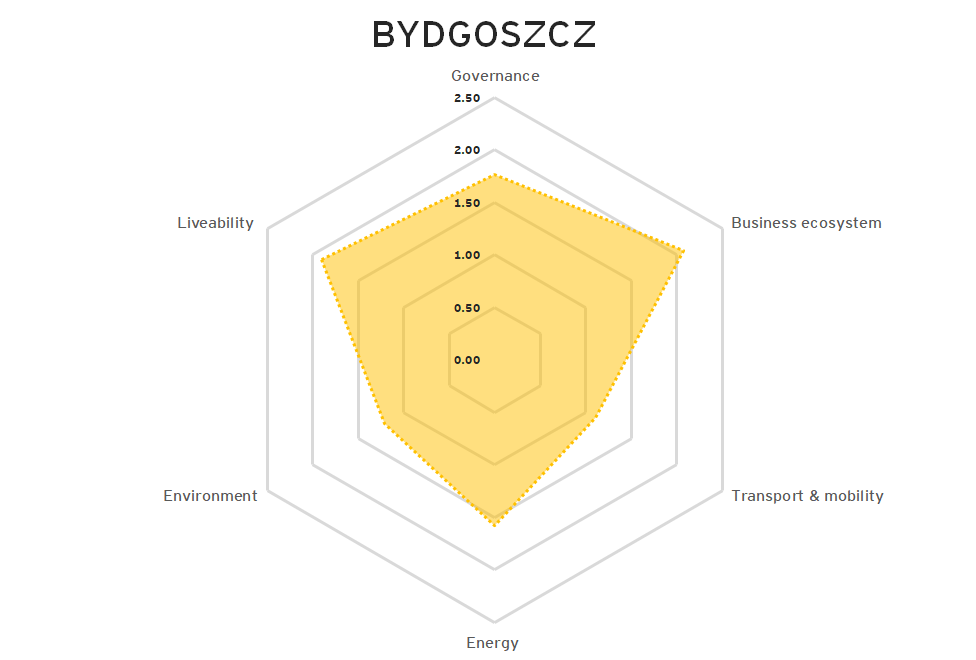
Strategy
Bydgoszcz has no cohesive SC strategy implemented, however, the SC objectives of the city are described in several documents and action plans as follows: Regional Operational Program of the Kuyavian-Pomeranian Voivodship for 2014-2020, Development Strategy for Bydgoszcz to 2030, Development Strategy for the Kuyavian-Pomeranian Voivodship to 2020 – Modernization Plan 2020+, and Regional Innovation Strategy for the Kuyavian-Pomeranian Voivodship for 2014-2020.
There is no separate and specialized unit or a spokesperson responsible for implementing the SC city concept in Bydgoszcz. However, there are several units within the city whose activities and conducted projects fit into the SC ideology: City Investment Department, European Union Funds Department, and Energy Management Team; the key reference point within the administrative structure is the Integrated Development Department.
Key Smart City actors and projects
The public entities identified within the project include Bydgoszcz’s Integrated Development Department, City Investment Department, Energy Management Team, Municipal Road and Public Transport Authority, Municipal Waterworks and Sewage, Voivodship Environmental Protection Inspectorate, Public Transport Authority, municipal heating provider, Bydgoszcz Regional Development Agency, and Kuyavian-Pomeranian Innovation Agency. The active stakeholders within Bydgoszcz’s private sector include regional firms as PESA; local branches of Skanska, Sii, Asecco, Mobica; entities working on the real estate and developer market, such as Optimum Park, Biznes Park Kraszewskiego or Rodźko Dewelopment; a well-known local startup Tickeo; academic entities: Wielki University, the University of Science and Technology, and WSB University; as well as NGOs and other associations, such as Fundacja REGION PLUS, Stowarzyszenie na Rzecz Rozwoju Transportu Publicznego, and Stowarzyszenie Społeczny Rzecznik Pieszych.
The flagship initiatives of Bydgoszcz include intelligent transport system, smart street lighting, Bydgoszcz Agglomeration City Bike, Municipal Teleinformation Network and Bydgoszcz City Card. Equally noteworthy are: the participatory budget, the system of social consultations, a network of hotspots, mobile apps for residents and tourists such as Metropolia Bydgoszcz, Aktywna Bydgoszcz, Bydgoszcz – Mobilny Przewodnik; smart solar benches, or cycle paths expansion. At the national level, Bydgoszcz is distinguished by environmental projects, which harness natural features of the region as well as participation in international initiatives. Thus, the city was awarded the honourable mention for the design and execution of the remodelling of the surface water drainage system at the industry SC Forum 2017. The city also participates in the CitiEnGov project aiming at defining energy plans, creating tools that support environmental protection and shaping energy policy.
SC opportunities and recommendations
During the survey, the city was described as the one having the highest citizens’ satisfaction level among the three Polish cities considered in this report, standing in the upper quartile of the overall city satisfaction level in Poland. Comparing the cities in the scope of the existing obstacles to SC projects, Bydgoszcz is slightly above the average mark, which means that the realization of SC projects is commonly going smoother there than it might be in Łódź or Warsaw. At the same time, Bydgoszcz was the only city putting a high responsibility of having SC obstacles on the lack of proven and accessible technology, which is a good feedback for the municipal government.
The analysis of the current SC development in terms of communication and citizens’ engagement showed that the city of Bydgoszcz, unlike other Polish cities, ignores a list of important SC activities and initiatives, which makes this area one of the highest priorities for the local government to focus on. Thus, for example, even though the SC labs, open data initiatives, and co-designing workshops concepts are not much developed in Poland, Bydgoszcz was ranked far behind both Warsaw and Łódź. Similarly, the city got the lowest score in terms of setting up and managing business accelerators, SC mobile applications, and face-to-face events, being slightly above the report’s average mark. Moreover, unlike other Polish cities, Bydgoszcz was reporting the lack of hackathons and open challenges.
Slovakia: Country Summary
Introduction: The development of Smart Cities (SC) in Slovakia is hampered by a number of challenges and risks, at least in the short-term horizon. SC projects are associated with various unique challenges that are often difficult to address in traditional models of infrastructure finance. One of the main challenges to the analysis was the relative novelty of the SC concept in Slovakia. While many projects that currently partially classify as SC projects are already in the planning or even implementation stage, they are rather isolated in their sectoral focus and approach of the municipal governments, addressing only partial SC elements using existing resources (both human and financial) in an inefficient way.
The analysis showed that only a part of these projects is based on existing municipal development strategies, and the majority reflects ad-hoc financing opportunities. The reasoning behind this is the lack of resources and expertise available at the point of developing the local SC related strategies, which is also evident throughout the implementation of SC-related projects – the complexity of the issue results in lengthy conceptualization of projects, limiting public procurement set-up, challenges in securing financing of the projects and ultimately procurement of solutions that are not fit for purpose.
The main documents dealing with the SC agenda on the national level in Slovakia are the Smart Specialization Strategy for the Slovak Republic, Research and Innovation strategy for smart specialization, Slovak Smart Industry Action Plan, strategy on Promoting Innovative Solutions in Slovak cities, and National Strategy for Regional Development in the Slovak Republic and its update for 2014-2020.
Apart from that, there are multiple strategies contributing to the SC agenda as the concept is complex and it has impact on various sectors such as transport, energy, or health.
The major public bodies responsible for the development of the SC agenda in Slovakia are: The Ministry of Economy, Office of the Deputy Prime Minister for Investments and Informatization, and Ministry of Transport and Construction.
While a few SC projects have already been implemented mostly as a result of EU funding, still most cities in Slovakia often find the SC concept development and project implementation quite challenging. At the same time, the municipalities are very interested in the development of the agenda as SC activities are very closely connected to innovation, R&D and digitization, and as such represent a new economic area in the Slovak Republic with high development potential. It is an emerging market segment where innovative solutions can be scaled at a fast pace, with the most common areas of SC projects as per today in Smart Mobility, Smart Environment, and Liveability.
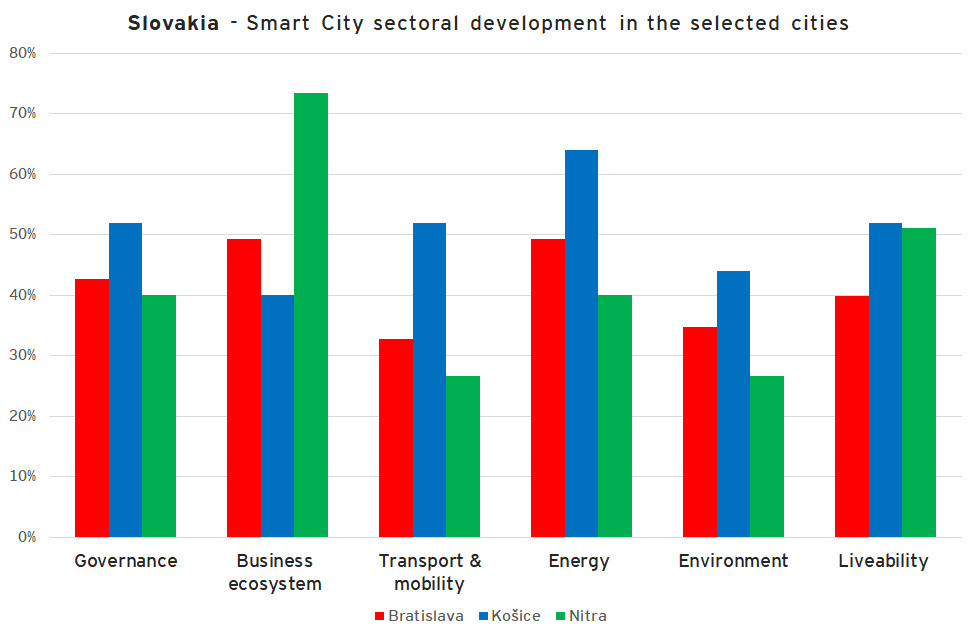
EY Self-Assessment tool f
As a consequence, just a half of the Slovak respondents managed to confirm that the cities they are based in fit into the definition of the SC. The analysis of the obstacles to the SC development in Slovakia showed that the existing regulatory framework was reported by the vast majority of the respondents, which is a common issue for all Visegrad. The other obstacles present that worth being mentioned are the lack of proven and accessible technology, the lack of human resources at the city level, and the outdated urban infrastructure.
In terms of SC projects financing, the most common form of funding used are the green bonds, EU grants. In addition, some cases of project support included also the provision of technical assistance. The other options present at the market but used less frequently are city, regional and national budget; the use of taxes and venture capital was also confirmed by a few municipalities. Considering the available forms of cooperation with municipalities, Slovak local authorities offer several forms of funding agreements, though simple contracting is still the most frequent approach.
Final recommendations: Taking into consideration the described SC situation in the country, Slovakia might implement a set of certain solutions in order to overcome the existing obstacles, facilitate the SC growth, and improve the overall quality of life in the cities.
Firstly, the activities leading to the improvement of the existing communication channels and citizen engagement could be set up as one of the main priorities for the local authorities due to the facts and the respondents’ feedback mentioned previously. The reader may get acquainted with more detailed recommendations in respect of the communication channels’ suggestions on the city level of the report.
Secondly, another important recommendation might be focusing on solving the most commonly reported obstacles to SC development. Hence, the reconsideration of the current regulatory framework could become the major scope of the Slovak government’s interest, which could be followed by the improvement of the local human resources’ capabilities, infrastructure renovation, and piloting the benefits of the innovative sustainable urban development technologies.
Lastly, the Slovak municipalities might continue expanding the list of available funding options, distributing the stress from simple contracting to other forms of possible cooperation; accompanying the expansion by the promotion of the advanced financial structuring.
Slovakia city level: Bratislava
Bratislava as the capital city of Slovakia is the center of business, finance, education, and creative industries; it is the seat of government administration and a list of various public entities.
Though the SC concept is not yet well developed in Slovakia, Bratislava is nowadays trying to promote sustainable urban development investing in people and the advanced innovative technologies, aiming at becoming a future SC leader.
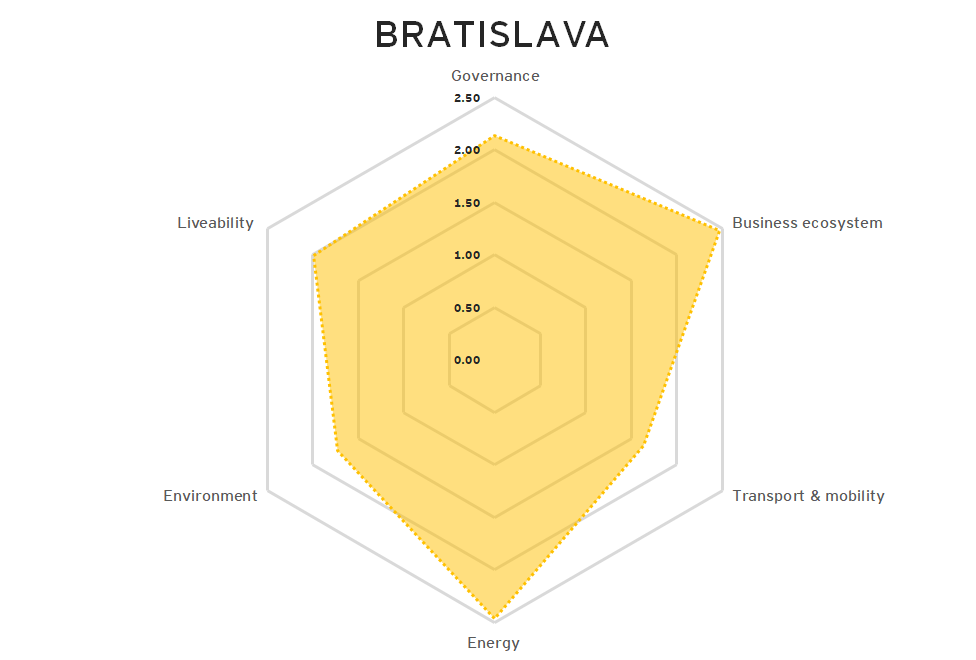
Strategy
Commonly for the cities in Slovakia, Bratislava has no SC strategy. Thus, previously there have been no specialized units created for the monitoring and enhancing the agenda on the local level, while the responsibility for developing the SC solutions and sustainable urban development for a long time lay within the city’s unit for strategic development. However, the municipality has recently assigned a person for the newly created position of a chief innovation officer, who should take over managing the issues connected to the SC agenda.
Key Smart City actors and projects
Being the capital, Bratislava has a rich ecosystem of stakeholders participating in the SC agenda. It includes such public institutes as Public Transport Company Bratislava, or Slovak Innovation and Energy Agency; private companies: Atos IT Solutions and Services, ATS Technologies, Virtual Reality Media, SIEMENS Slovakia, T-mobile, ČSOB or Tatra bank; academia institutions: Comenius University in Bratislava, and Slovak university of technology in Bratislava; as well as various associations, clubs and NGOs: SIEA Slovak Innovation and Energy Agency, Energy Centre Bratislava, and others.
Though in terms of SC projects Bratislava is in an early stage of development, there is a positive trend confirming the growth of the SC solutions, showing promising perspective results. For example, the following SC projects were implemented in the city: Sensoneo Smart Waste Management, the operation of an emission-free zone with fully automated ATS technology, the installation of solar benches that charge mobile phones or offer Wi-Fi connection.
SC opportunities and recommendations
The city was reported as the one having the highest level of citizen city satisfaction among other Slovak municipalities considered in this report. Similarly, Bratislava takes the lead as a city fitting to the SC concept the most in the country.
However, even though the city has higher overall rankings within Slovakia, it was still ranked just slightly above the average level of the overall report, leaving a significant potential for further improvement.
The respondents claimed that the municipal authorities are quite passive in terms of the improvement of the quality of life in the city; in addition, less than 20% of citizens are aware of the city’s vision and strategy in the area of sustainable urban development; which altogether may serve as a solid confirmation of both the lack of the communication between the stakeholders on different levels, as well as the inefficient municipal approach to SC the agenda.
Similarly to the city of Košice, the assessment of Bratislava in terms of the obstacles to the SC projects and initiatives showed the city is struggling with a few quite major issues. The most problematic areas for the capital city are the existing regulatory framework, infrastructure ownership structures, outdated urban infrastructure, and lastly the lack of investment, which was ranked as the most challenging issue.
The survey confirmed that both citizens and the representatives of the private sector of the city equally possess the highest interest in Slovakia towards the participation in the SC activities and contributing to the development of sustainable urban development. At the same time, commonly for other municipalities in the country, Bratislava slightly lacks behind other larger cities of the Visegrad region. For example, the respondents claimed that Bratislava is well capable in terms of the organization of face-to-face events and managing the smart web-based portal, having not enough hackathons, open challenges, and co-designing workshops, as well as weak SC mobile applications. Lastly, according to the respondents’ feedback, the city is weak in terms of the setting up and maintaining SC labs, accelerators, and Open Data initiatives, which could become the areas the local municipalities could put the enhancement stress on.
Slovakia city level: Košice
Introduction
Košice is the second largest city in Slovakia. In terms of SC assessment, the city has an overall lower SC ranking, having though a significant future potential as the economic and cultural center of eastern Slovakia.
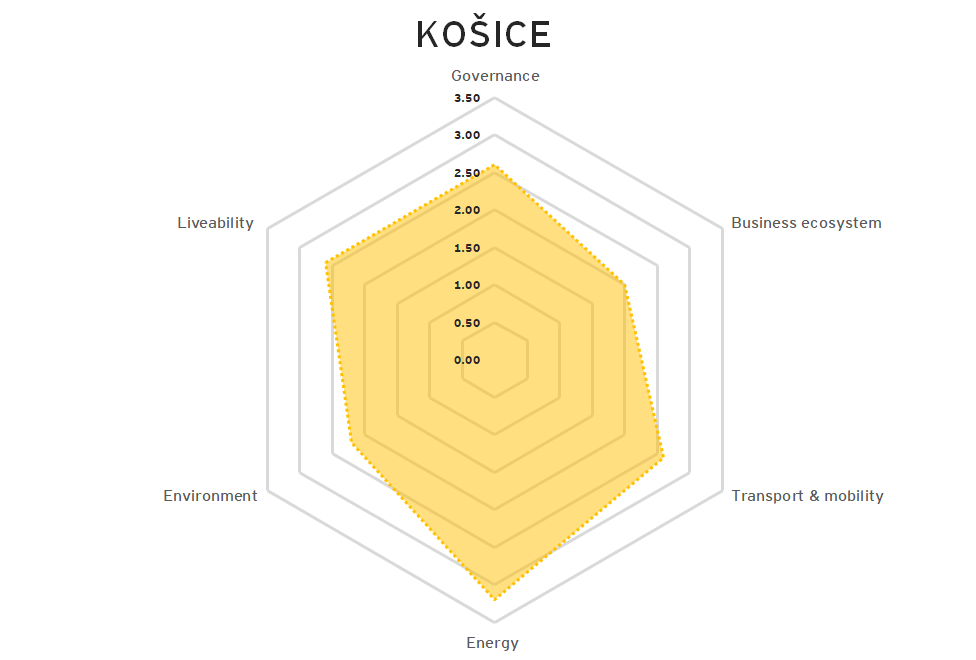
Strategy
The city has no SC strategy. At the same time, there have been no special units created for dealing with the smart solutions, while the public body taking the main responsibility for the smart agenda decisions in Košice is the vice mayor office.
Key Smart City actors and projects
Although the SC concept in Košice is at an early stage of the development, the city has a rich ecosystem consisting of both public and private entities, banks, insurance companies, and non-governmental organizations. Thus, for example, the local ecosystem consists of such public entities as Tepelné hospodárstvo of Košice, Dopravny Podnik Mesta Kosice, TEKO – Teplaren Kosice, Železničná spoločnosť Slovensko; local private companies such as Západoslovenská energetika (ZSE), Slovenská elektrizačná prenosová sústava; academia entities: Technical University of Košice, and Pavol Jozef Safarik University; associations, clubs, and NGOs: startup center at Technical University of Kosice, CC Slovensko, Slovak Chamber of Commerce and Industry, or KOSIT.
Considering the list of SC projects successfully implemented in the city of Košice it is worth mentioning that the city has traditionally aimed at the areas of smart mobility and liveability. The projects include the modernization of the traffic management system at crossroads allowing the dispatchers to monitor the situation with dozens of cameras; Košice has also been the first city in Slovakia to use the UBIAN application to help travellers, providing them with access to all the traffic information using the smartphone; “Pay to Plate” smart parking system was introduced with the use of a central database of vehicle registration numbers; among other SC projects implemented in Košice the reader may find such solutions as the modernization of central public transport dispatching, creation of new terminals of integrated transportation, modernization of public transport bus stops, modernization of maintenance framework for depot, modernization of ticket check-in system and information system in public transport; smart neighbourhood solutions aimed at the integration of multiple smart ways to revitalize the public spaces including public lighting solution, smart parking, security and safety element; as well as the revitalization of neglected parts of the city and usage of these for recreational, sport and leisure activities.
SC opportunities and recommendations
The citizens of Košice reported an above-average level of city satisfaction, thus Košice closely follows the capital of Slovakia, which was reported as the best city to live in. Overall, the consortium members spotted a trend confirming that Košice and Bratislava have many common features and obstacles in terms of the SC projects and sustainable urban development. Thus, for example, the respondents of Košice claimed that the local municipalities stick to a quite passive approach towards the continuous enhancement of the quality of life in the city. Moreover, according to the survey, the city has the lowest fit into the SC concept; while the respondents showed a lower interest towards the participation in the urban development, slightly exceeding the report’s average level, though nearly the whole sample confirmed the understanding the smart solutions’ importance for the improvement of the overall quality of life in the city.
The survey showed that Košice, similarly to Bratislava, has a list of obstacles to the development of the sustainable urban development and successful SC projects’ implementation. They are mainly connected to the security and privacy issues, lack of proven and accessible technologies, lack of investments and human resources at the municipal level.
In terms of the SC activities, the situation in Košice stands in line with its overall evaluation outcomes. Thus, the city commonly lacks behind the majority of other Visegrad region municipalities, having an average level of confidence in terms of smart mobile applications, face-to-face events, and co-designing workshops; closing the list of the Slovak cities.
The municipal authorities might
consider developing the local hackathons and open challenges, SC labs, business
accelerators, as well as promoting the open data initiatives; in addition, the
city might decide to invest in the human capital on the municipal level,
piloting innovative SC solutions, as well as creating the investor-friendly
environment.
Slovakia city level: Nitra
Introduction
Nitra is a town with a rich history located in the western part of Slovakia. It is an important local pioneer of the SC concept. Nitra is gradually becoming a SC, constantly implementing various smart solutions to modernize the existing ecosystem and improve the residents’ quality of life. In June 2017 the city was awarded the Smart Leader’s certificate for its innovative approach to smart solutions through implementing the concept into real-life with modern projects and innovative urban development strategies.
Nitra is planning to keep the lead in the following years with the focus on the public services and state-of-the-art technologies such as the modernization of technical facilities, lighting, parking and public transport. In order to reconcile these activities, there has been formed a working group composed of professionals from various fields who would aim at various aspects of urban development, steadily increasing the living standards of the town.
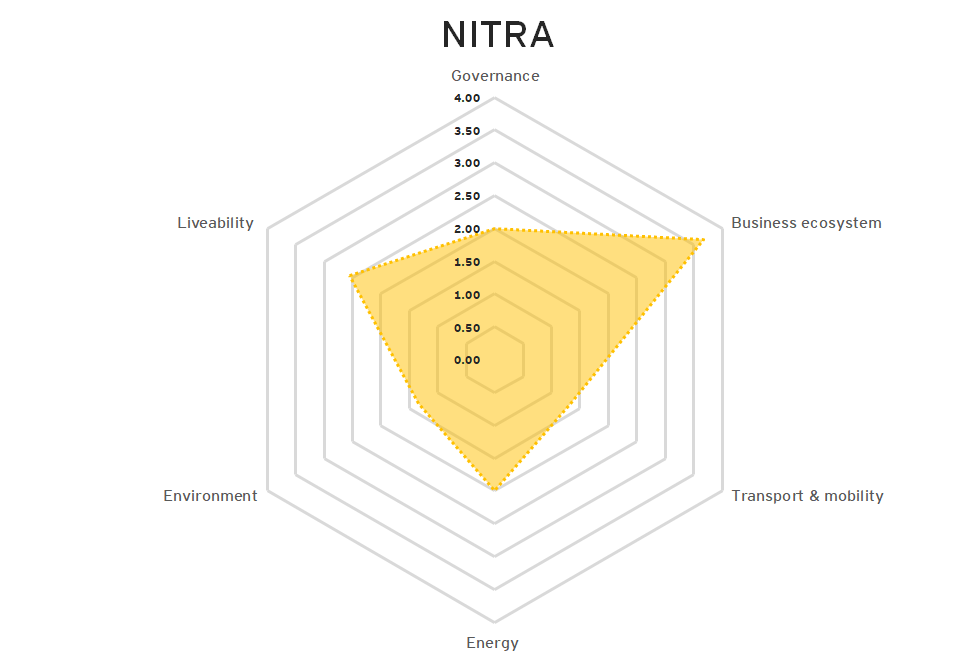
Strategy
The city’s SC strategy is fragmented, its main features are outlined in the following documents: Sustainable Urban Mobility Plan, Sustainable Energy Action Plan, Energy Strategy of the City of Nitra, the 2020 Greenhouse Gas Emissions Action Plan, and the Covenant of Mayors on Emission Reduction.
Due to the fact that there is no specified public body dealing with the agenda, the main responsibility on the strategic smart decision making in Nitra lays on the mayor office.
Key Smart City actors and projects
The smart ecosystem of the city is represented by a variety of active stakeholders: public entities as for example Agrokomplex – Výstavníctvo Nitra, Energo-sk, Regionálna správa a údržba ciest Nitra, Agroinštitút Nitra, Západoslovenská vodárenská spoločnosť, Slovak Business Agency, Nitrianska teplárenská společnost, or Transpetrol; the private firms that include both smaller local companies as Západoslovenská energetika, as well as larger entities as Slovenská elektrizačná prenosová sústava, SIEMENS, Penta Investments, T-mobile, SEAK, or GreenWay Infrastructure; banks and insurance companies: Tatra bank, VÚB bank, OTP, UniCredit, Slovenská sporitelňa, Allianz or KOOPERATIVA; associations and clubs: ZMOS, Union of Slovak cities, Národná dialničná spoločnosť; as well as academia entities, for example the Constantine the Philosopher University in Nitra.
Nitra has implemented a range of SC projects aimed at the reduction of the energy costs of many public buildings and educational institutions through the implementation of various smart tools like green roofs. The city has set up 140 semi-ground municipal smart waste containers and built an innovative composting plant which is also capable of recycling aluminium packaging from beverages. Nitra has installed 1,345 smart power saving LEDs replacing the old and less efficient street lights. In addition to that, the municipality has implemented an online urban sports and cultural objects booking system, modern urban cameras system, as well as installed numerous intelligent benches in the city center. Promoting energy efficiency and smart mobility Nitra has been implementing Green Roofs, bike sharing system, smart parking system ParkDots, safe pedestrian zones, as well as plans to establish a developed network of more than 50 charging stations ranging from regular to ultra-fast enabling fluent transfer of electric cars from Western to Eastern Europe.
SC opportunities and recommendations
According to the survey, Nitra was rated quite low in terms of overall city satisfaction. In addition, the city indicated having poor communication channels and citizens engagement, as well as relatively low citizen SC strategy awareness. Moreover, the report confirmed a low level of the citizens’ willingness to contribute to the smart urban development, locating the city just above the report’s average mark.
At the same time, a promising positive trend was spotted. Thus, the respondents confirmed that the local authorities are constantly trying to improve the living conditions in the city, ranking this SC assessment parameter in Nitra better than in other Slovak cities, resulting in the city’s better fit into the SC concept.
Similarly, the overview of the obstacles to the SC development in Nitra confirmed the improving SC development tendencies in the city. The respondents stated that the municipality has the lowest severity of obstacles to the implementation of smart projects than other Slovak cities do, putting the stress on the lack of consumer demand as the major issue currently present in the city.
Taking a closer look at the existing SC activities, the reader may notice an interesting segregation of the activities as some of them are reported as well-developed and common for the city, while others are hardly developed. Such a split might confirm the existing tendencies of the SC growth, proving that the local municipalities tend to invest resources in the SC promotion.
The city government might consider further enhancement of the communication channels, citizen engagement and education, which altogether should allow the city to overcome the existing SC obstacles creating higher consumer demand. In terms of the citizens’ engagement and SC activities, the local municipalities could focus on the organization and maintenance of SC labs, business accelerators, investing in smart mobile applications, and facilitating open data initiatives.
Self-Assessment tool Disclaimer
During the compilation of the report the consortium members deployed the EY Self-Assessment tool (SAT) to collect the data about Smart City development of the selected cities from a set of various stakeholders (municipal authorities, private companies, and citizens). The views and infographics presented in this report represent solely the responses from participants having completed the SAT. The project partners are not liable for the validity of the views and infographics, nor its representation of the actual state of affairs in the respective areas, on city and national level.
The data collection questionnaires were filled in by the respondents of various age groups. The largest respondents’ sample belongs to the age group of 30 to 50 years old (45%), followed by 18 to 30 years old (43%), and lastly 50 to 70 years old (11%). When it comes to the respondents’ sector of activity, the largest respondents’ group is represented by individuals representing the Private sector (44%), followed by Public sector (27%), and Academia (24%). In terms of the respondents’ field of employment, the research covers various groups including IT / technology, R&D, Real Estate, Oil and Gas, Private Equity, Consulting services, Consumer products & Retail, Mining and Metals, Automotive industries and Transport, and Financial services.
Disclosing the Private entities, the report covered the entities from the sectors including Automotive industries and Transportation, Real Estate, Hospitality and Construction, Private Equity, Power and Utilities, and Consulting services. Out of all the companies approached, over a half (56%) have never experienced working with Smart City (SC) projects. Only 38% of the companies have joined a SC-related alliances or partnerships. Lastly, over 26% of companies were participating in incubator/accelerator environment to develop new ideas. According to the report, the reader may derive that there is a large number of companies that already joined SC initiatives, however on the other hand, the room for the improvement remains significant.
Due to the fact that the number of
respondents was limited, the outcome presented in this report should be considered as an indication of the overall situation in the Visegrad
region only, as it does not represent the
views of the majority of
the local stakeholders.





